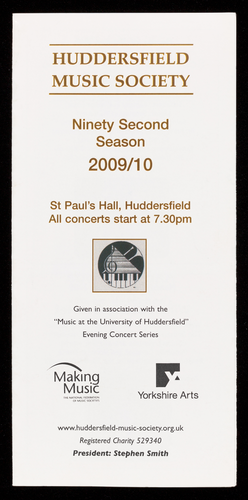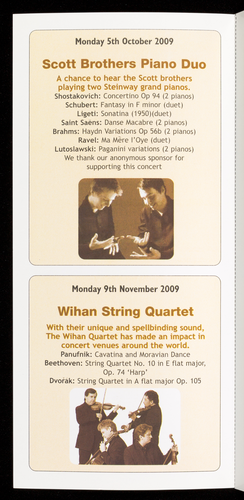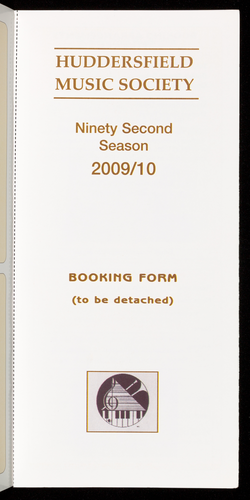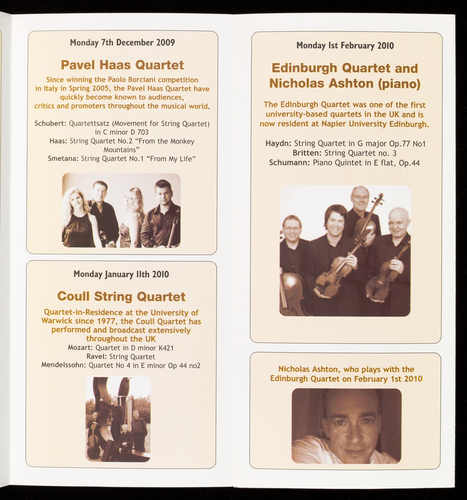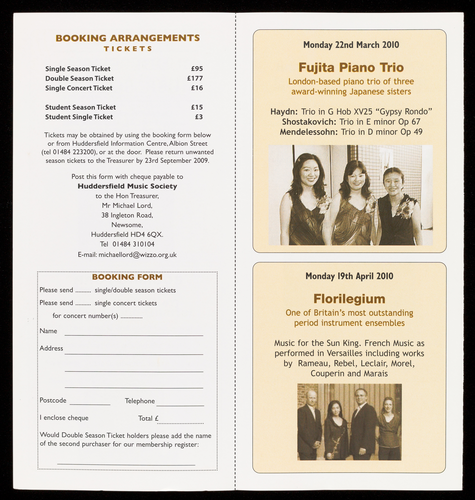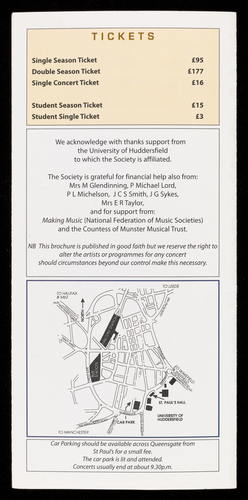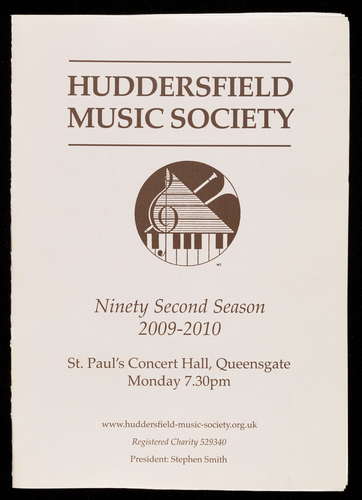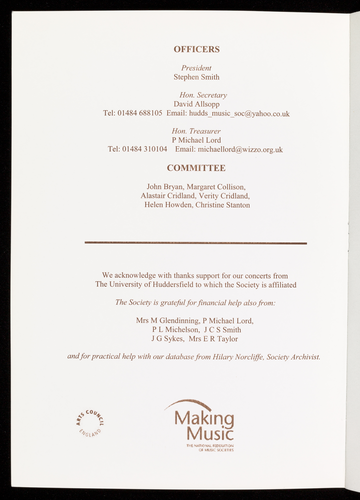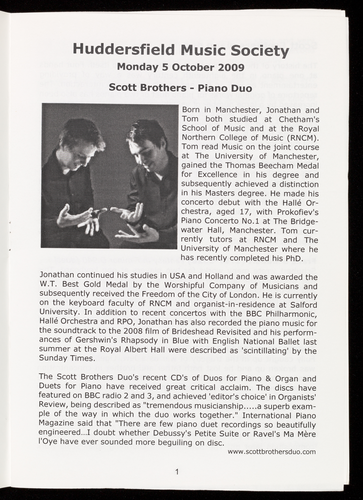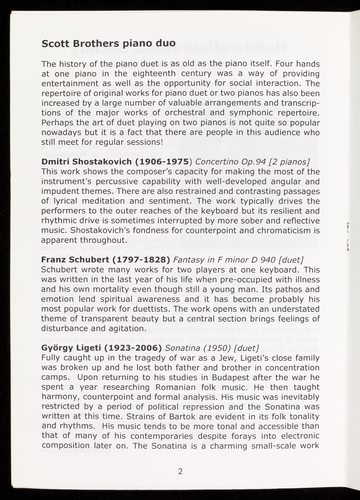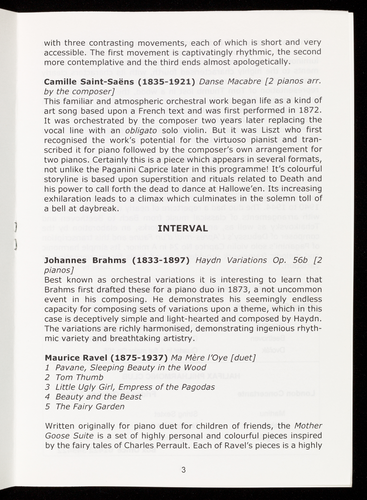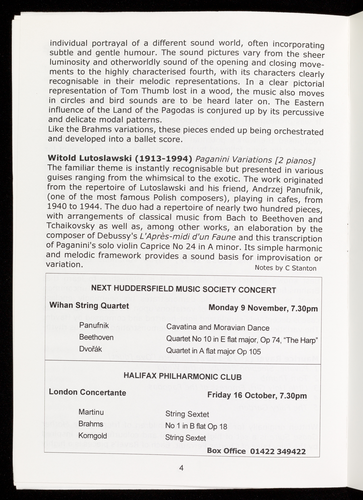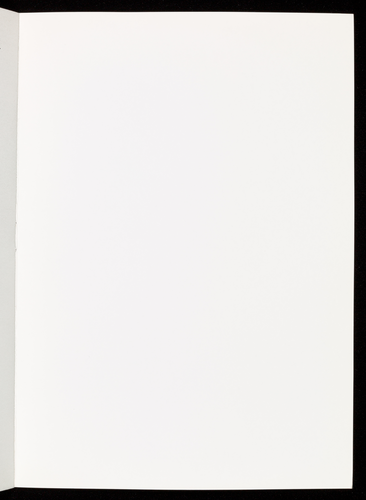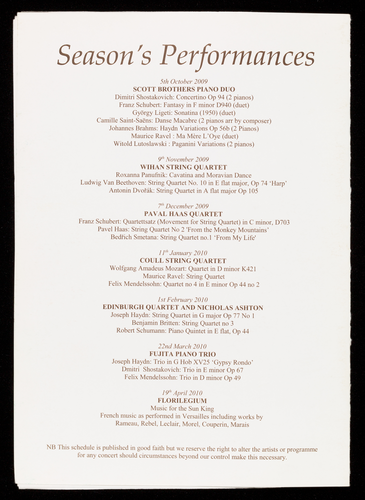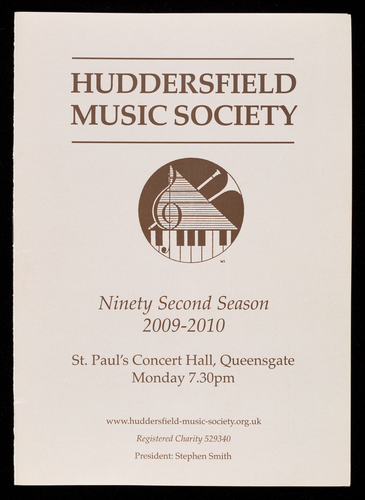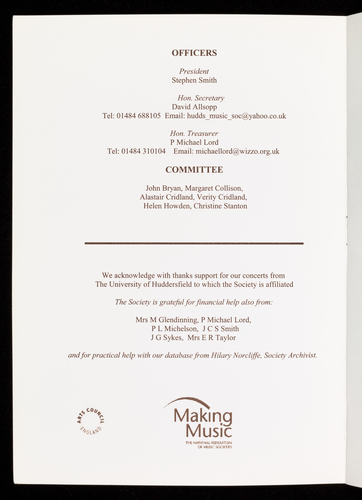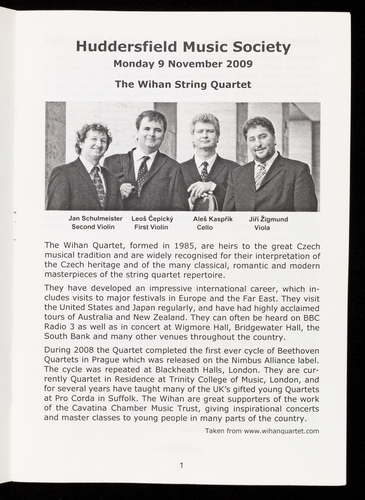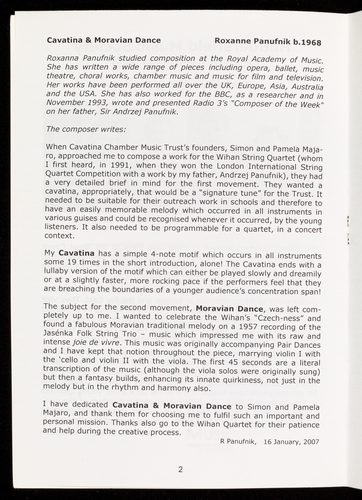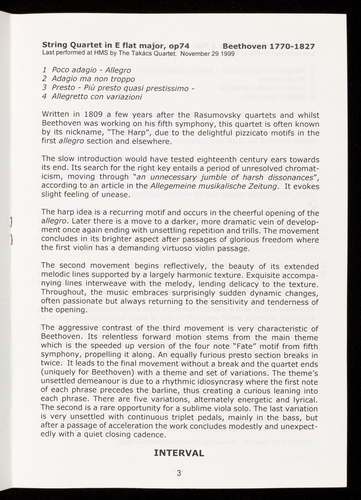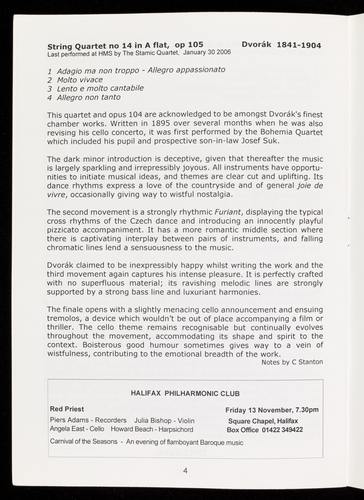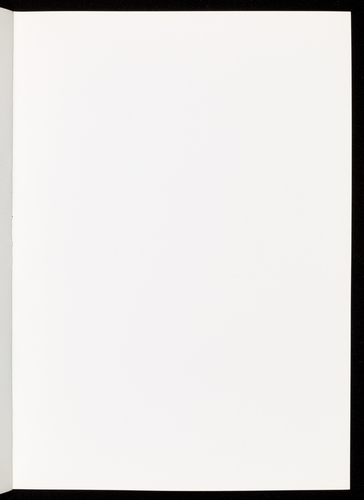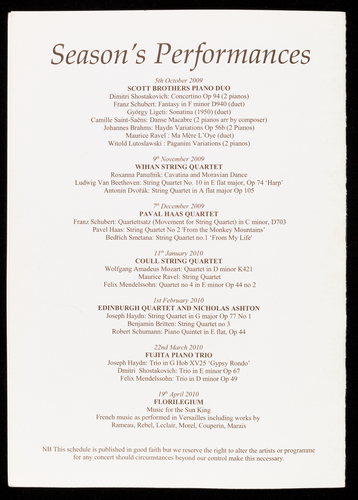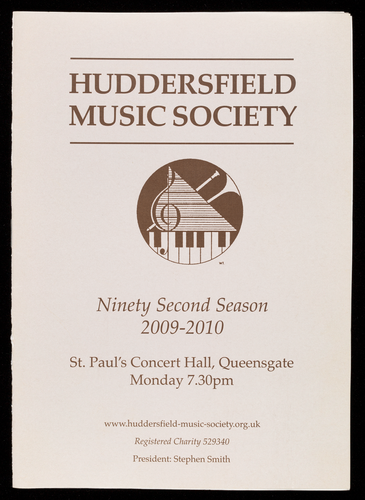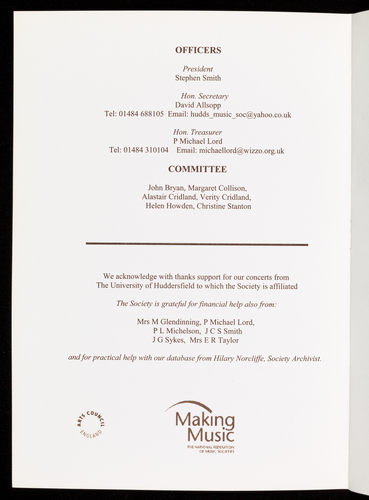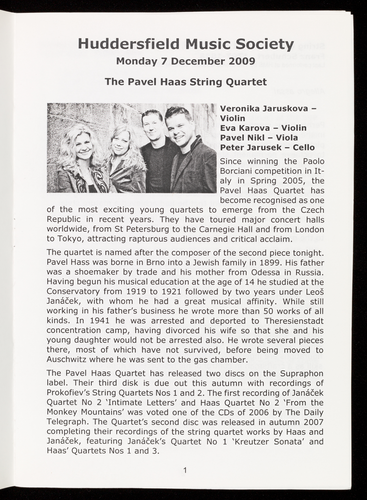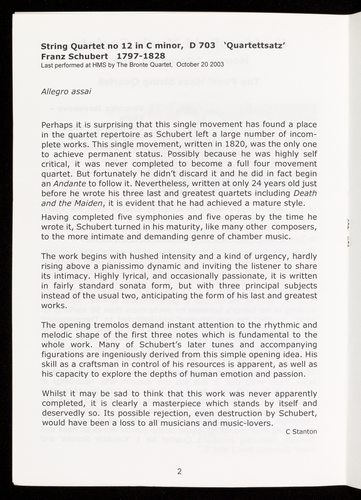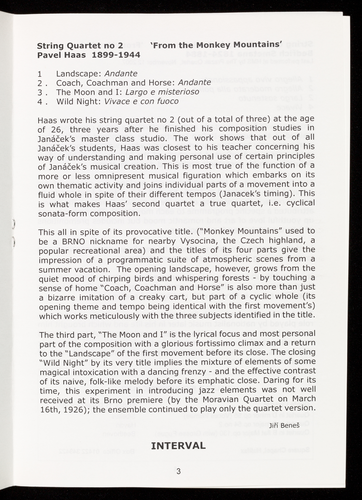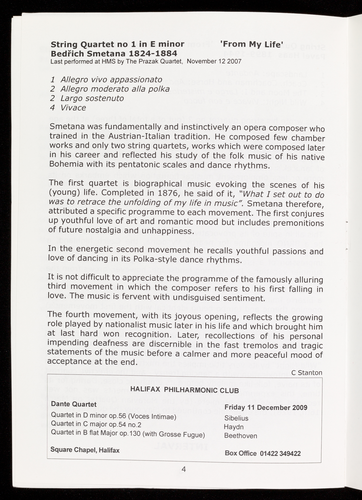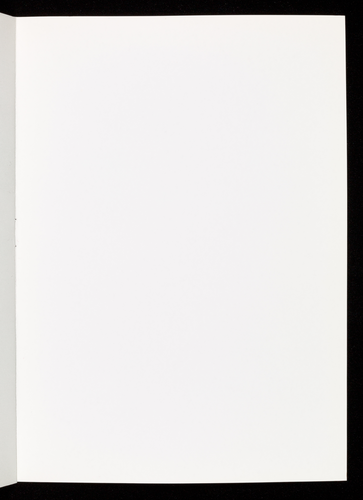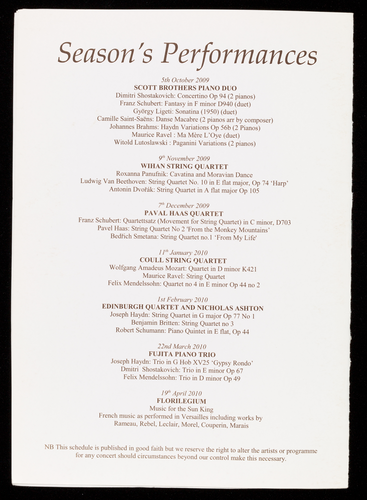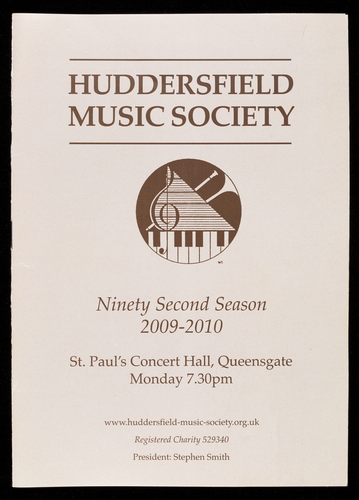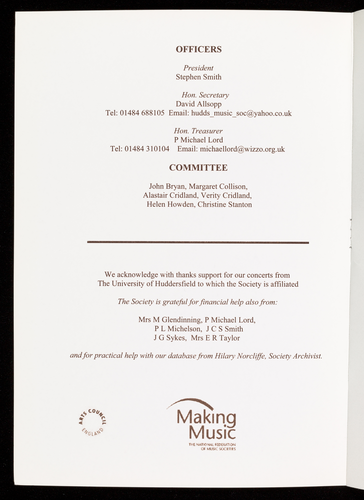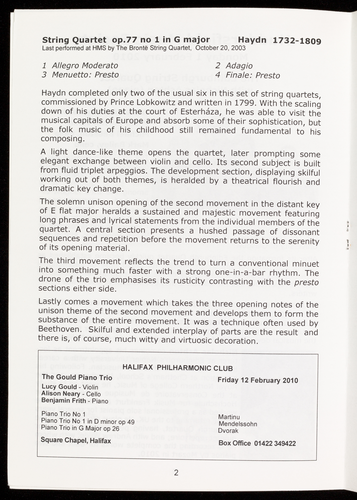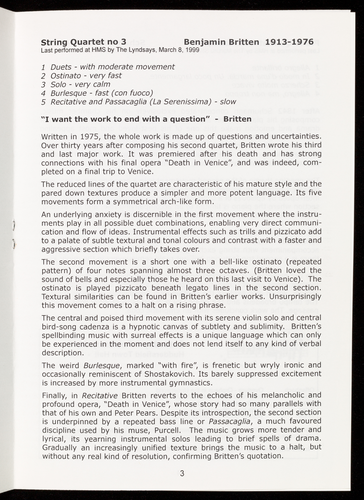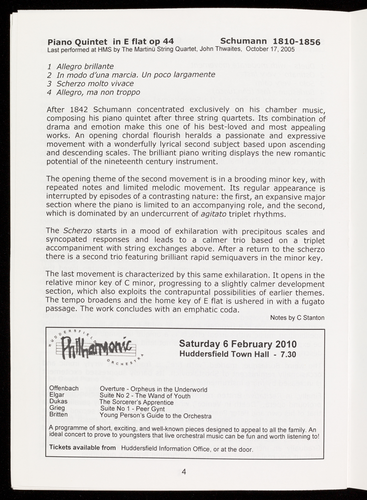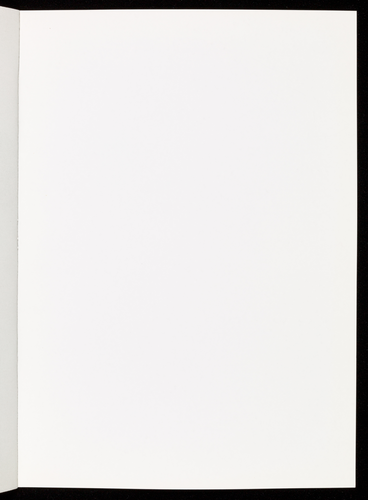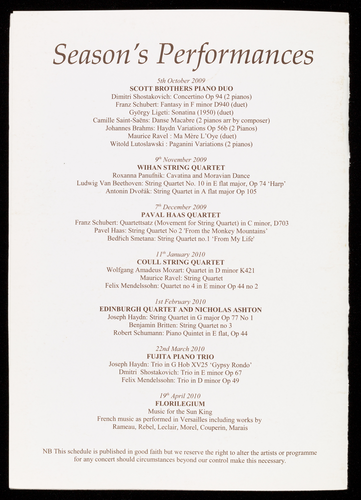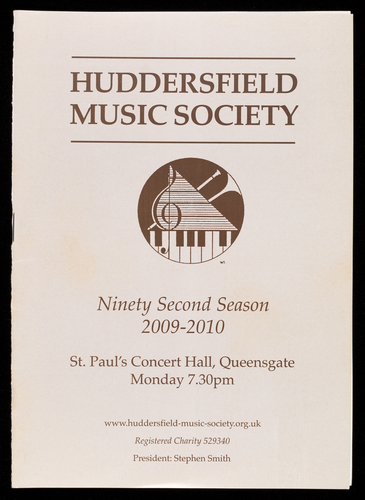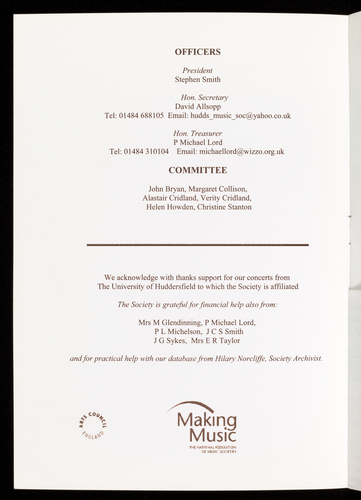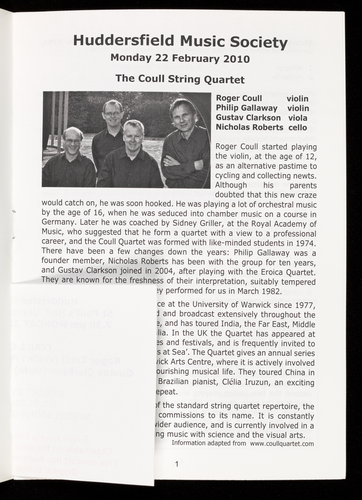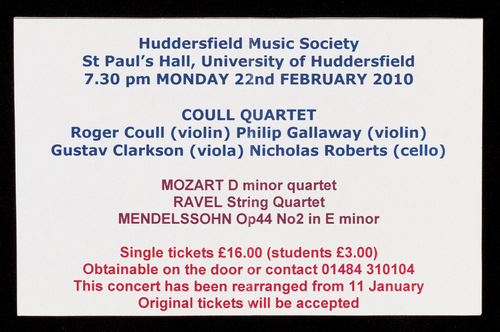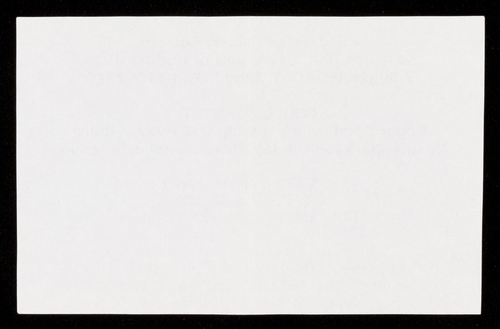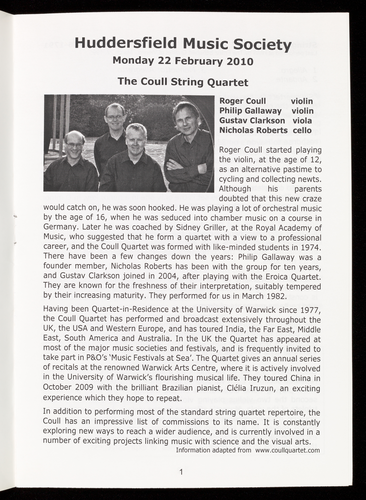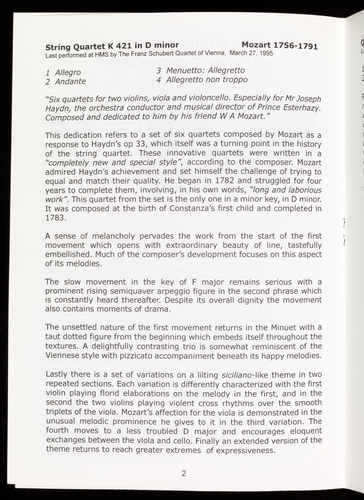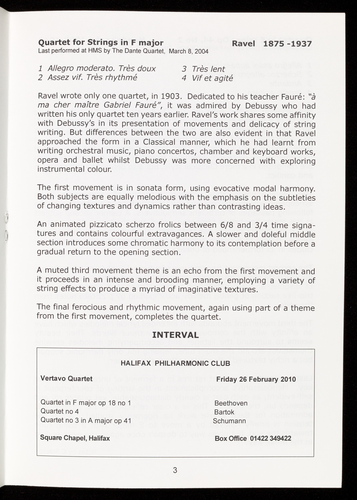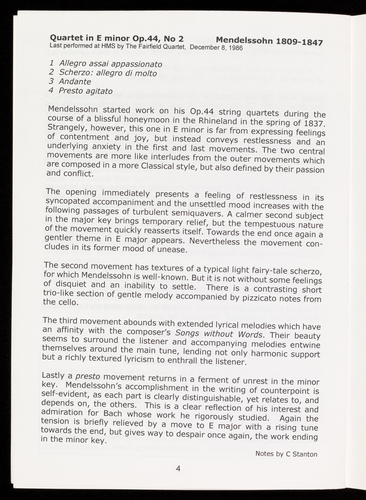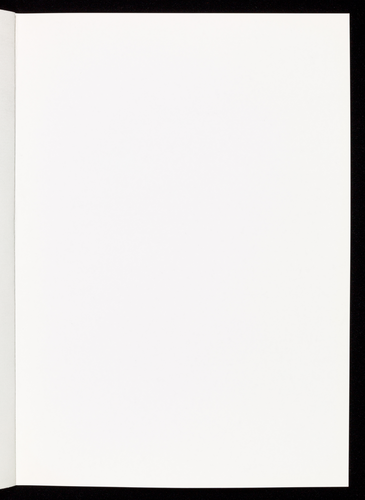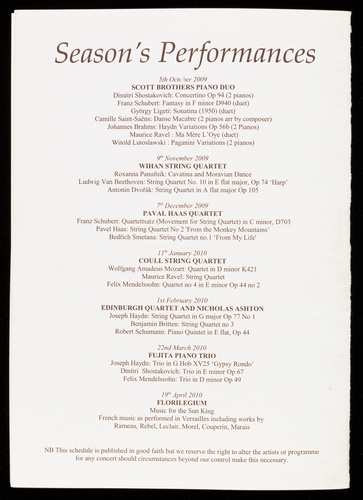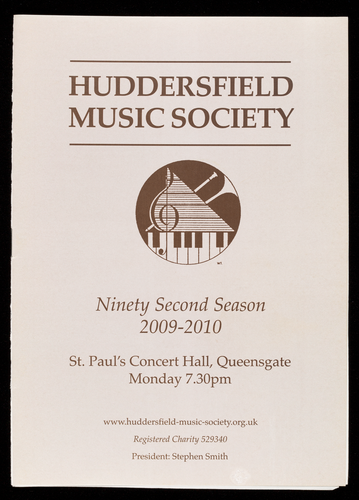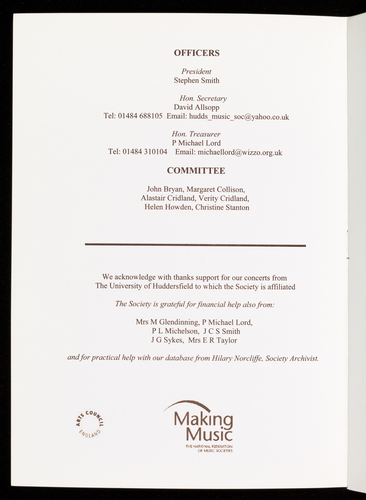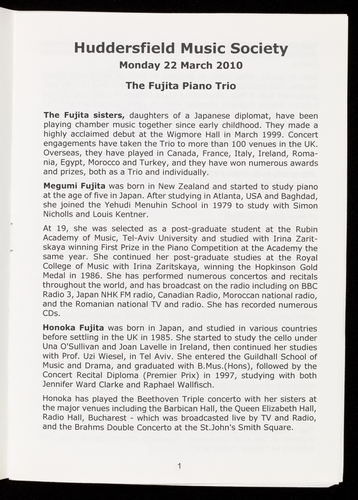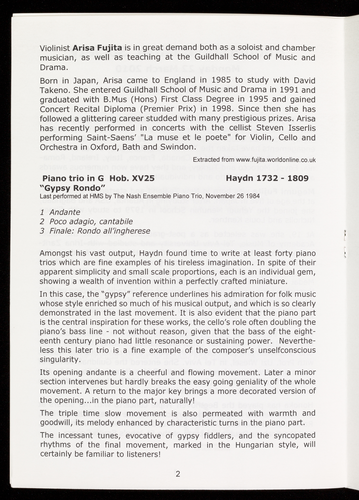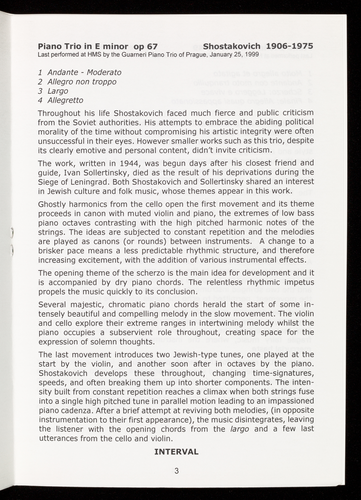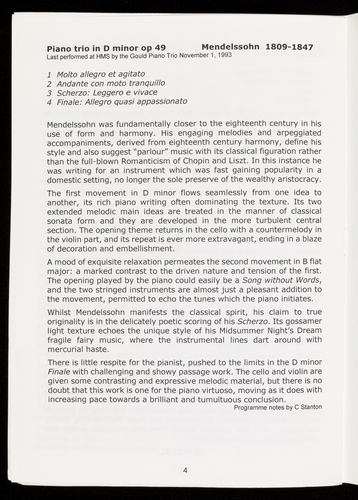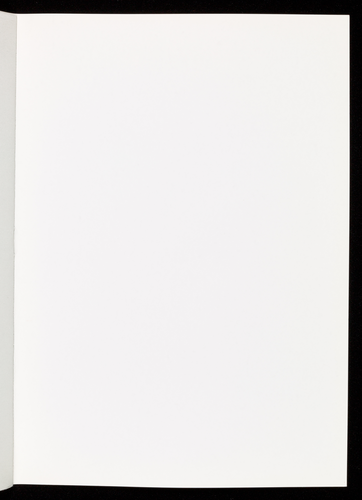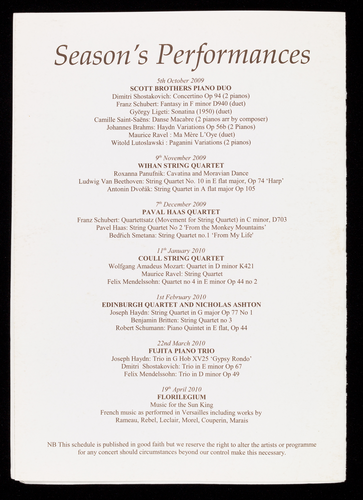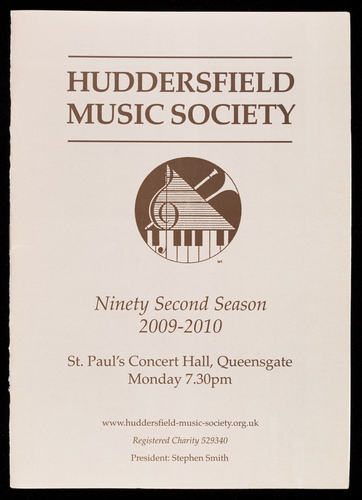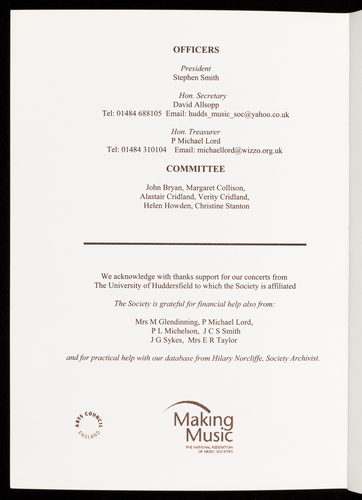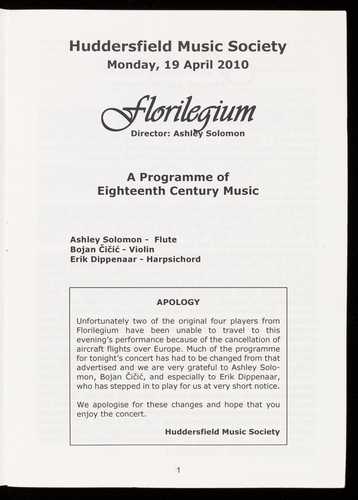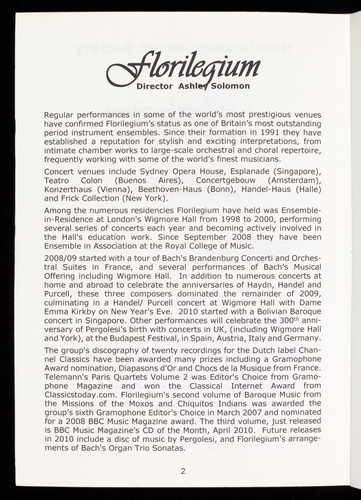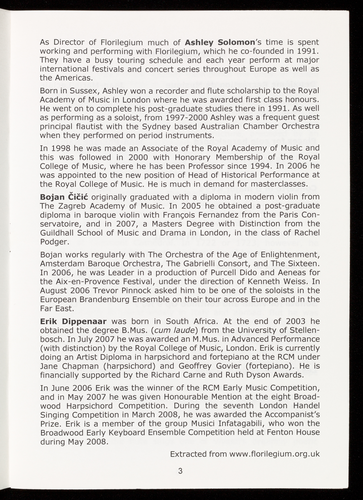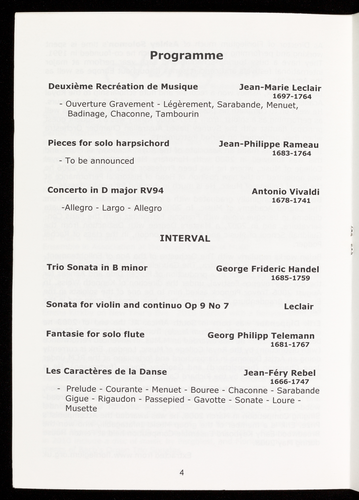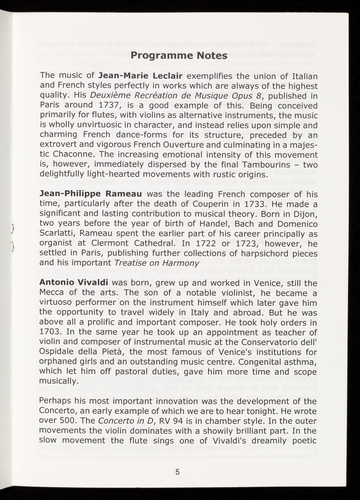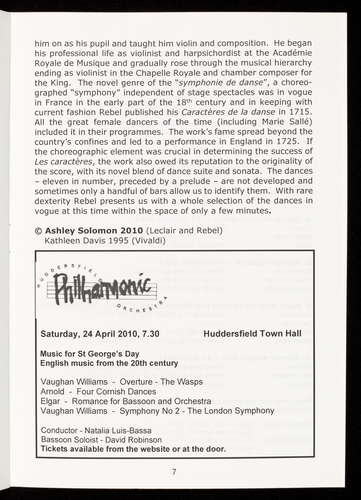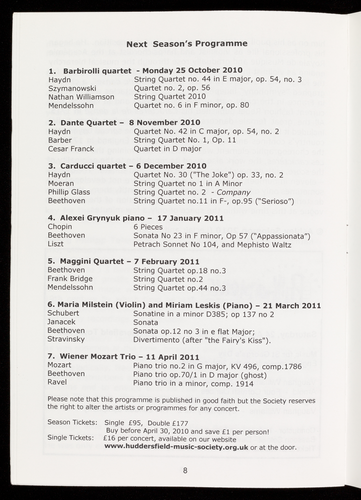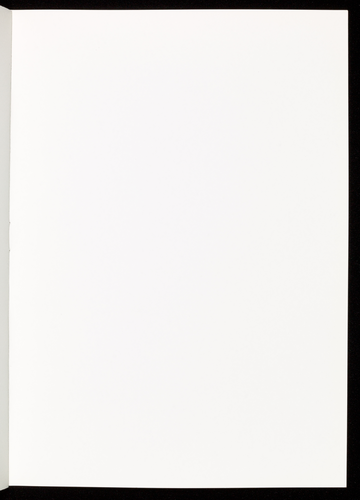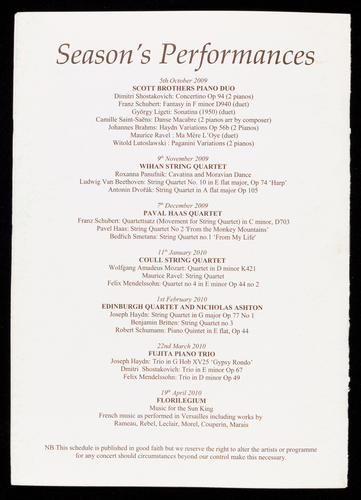Ocr'd Text:
HUDDERSFIELD
MUSIC SOCIETY
Ninety Second
Season
2009/10
St Paul's Hall, Huddersfield
All concerts start at 7.30pm
Given in association with the
"Music at the University of Huddersfield"
Evening Concert Series
Making
Music
THE NATIONAL FEDERATION
OF MUSIC SOCIETIES
Yorkshire Arts
www.huddersfield-music-society.org.uk
Registered Charity 529340
President: Stephen Smith
Ocr'd Text:
Monday 5th October 2009
Scott Brothers Piano Duo
A chance to hear the Scott brothers
playing two Steinway grand pianos.
Shostakovich: Concertino Op 94 (2 pianos)
Schubert: Fantasy in F minor (duet)
Ligeti: Sonatina (1950) (duet)
Saint Saëns: Danse Macabre (2 pianos)
Brahms: Haydn Variations Op 56b (2 pianos)
Ravel: Ma Mère l'Oye (duet)
Lutoslawski: Paganini variations (2 pianos)
We thank our anonymous sponsor for
supporting this concert
B
T
Monday 9th November 2009
Wihan String Quartet
With their unique and spellbinding sound,
The Wihan Quartet has made an impact in
concert venues around the world.
Panufnik: Cavatina and Moravian Dance
Beethoven: String Quartet No. 10 in E flat major,
Op. 74 'Harp'
Dvořák: String Quartet in A flat major Op. 105
Ocr'd Text:
HUDDERSFIELD
MUSIC SOCIETY
Ninety Second
Season
2009/10
BOOKING FORM
(to be detached)
Ocr'd Text:
Monday 7th December 2009
Pavel Haas Quartet
Since winning the Paolo Borciani competition
in Italy in Spring 2005, the Pavel Haas Quartet have
quickly become known to audiences,
critics and promoters throughout the musical world.
Schubert: Quartettsatz (Movement for String Quartet)
in C minor D 703
Haas: String Quartet No.2 "From the Monkey
Mountains"
Smetana: String Quartet No.1 "From My Life"
Monday January 11th 2010
Coull String Quartet
Quartet-in-Residence at the University of
Warwick since 1977, the Coull Quartet has
performed and broadcast extensively
throughout the UK
Mozart: Quartet in D minor K421
Ravel: String Quartet
Mendelssohn: Quartet No 4 in E minor Op 44 no2
Monday Ist February 2010
Edinburgh Quartet and
Nicholas Ashton (piano)
The Edinburgh Quartet was one of the first
university-based quartets in the UK and is
now resident at Napier University Edinburgh.
Haydn: String Quartet in G major Op.77 No1
Britten: String Quartet no. 3
Schumann: Piano Quintet in E flat, Op.44
Nicholas Ashton, who plays with the
Edinburgh Quartet on February 1st 2010
b
Ocr'd Text:
BOOKING ARRANGEMENTS
Single Season Ticket
Double Season Ticket
Single Concert Ticket
Student Season Ticket
Student Single Ticket
Please send
Please send
Tickets may be obtained by using the booking form below
or from Huddersfield Information Centre, Albion Street
(tel 01484 223200), or at the door. Please return unwanted
season tickets to the Treasurer by 23rd September 2009.
Name
Address
TICKETS
Post this form with cheque payable to
Huddersfield Music Society
to the Hon Treasurer,
Mr Michael Lord,
38 Ingleton Road,
Newsome,
Postcode
Huddersfield HD4 6QX.
Tel 01484 310104
E-mail: michaellord@wizzo.org.uk
.........
.........
for concert number(s)...
I enclose cheque
BOOKING FORM
single/double season tickets
single concert tickets
............
Telephone
£95
£177
£16
Total £
£15
£3
Would Double Season Ticket holders please add the name
of the second purchaser for our membership register:
Monday 22nd March 2010
Fujita Piano Trio
London-based piano trio of three
award-winning Japanese sisters
Haydn: Trio in G Hob XV25 "Gypsy Rondo"
Shostakovich: Trio in E minor Op 67
Mendelessohn: Trio in D minor Op 49
Monday 19th April 2010
Florilegium
One of Britain's most outstanding
period instrument ensembles
Music for the Sun King. French Music as
performed in Versailles including works
by Rameau, Rebel, Leclair, Morel,
Couperin and Marais
Ocr'd Text:
Single Season Ticket
Double Season Ticket
Single Concert Ticket
Student Season Ticket
Student Single Ticket
We acknowledge with thanks support from
the University of Huddersfield
to which the Society is affiliated.
TICKETS
The Society is grateful for financial help also from:
Mrs M Glendinning, P Michael Lord,
PL Michelson, JC S Smith, JG Sykes,
Mrs E R Taylor,
TO HALIFAX
& M62
and for support from:
Making Music (National Federation of Music Societies)
and the Countess of Munster Musical Trust.
A629
NB This brochure is published in good faith but we reserve the right to
alter the artists or programmes for any concert
should circumstances beyond our control make this necessary.
NEW NORTH ROADO
TRINITY STREET
NORTH
CASTLE GATE
STATION
BUS
TO MANCHESTER
A62 MANCHESTER ROAD
BOD
RAILWAY STATION
400
070
30
1009
00G00
୦୦୮
001
A616 CHAPEL HILL
QUEESINGATE
CAR PARK
Car Parking should be available
QUEESN ST SOUTHO
SOUTHGATE
TO LEEDS
LEEDS ROAD A62
QUEENSCA
£95
£177
£16
£15
£3
ST. PAUL'S HALL
UNIVERSITY OF
HUDDERSFIELD
TO WAKEFIELD
SHEFFIELD
A629 WAKEFIELD ROAD
St Paul's for a small fee.
The car park is lit and attended.
Concerts usually end at about 9.30p.m.
across Queensgate from
Ocr'd Text:
HUDDERSFIELD
MUSIC SOCIETY
WT.
Ninety Second Season
2009-2010
St. Paul's Concert Hall, Queensgate
Monday 7.30pm
www.huddersfield-music-society.org.uk
Registered Charity 529340
President: Stephen Smith
Ocr'd Text:
ARTS
OFFICERS
ENGLAND
President
Stephen Smith
COUNCIL
Hon. Secretary
David Allsopp
Tel: 01484 688105 Email: hudds_music_soc@yahoo.co.uk
Hon. Treasurer
P Michael Lord
Tel: 01484 310104 Email: michaellord@wizzo.org.uk
We acknowledge with thanks support for our concerts from
The University of Huddersfield to which the Society is affiliated
The Society is grateful for financial help also from:
Mrs M Glendinning, P Michael Lord,
PL Michelson, JC S Smith
JG Sykes, Mrs ER Taylor
and for practical help with our database from Hilary Norcliffe, Society Archivist.
COMMITTEE
John Bryan, Margaret Collison,
Alastair Cridland, Verity Cridland,
Helen Howden, Christine Stanton
Making
Music
Ocr'd Text:
2
Huddersfield Music Society
Monday 5 October 2009
Scott Brothers - Piano Duo
CAR
d
M
Jonathan continued his studies in USA and Holland and was awarded the
W.T. Best Gold Medal by the Worshipful Company of Musicians and
subsequently received the Freedom of the City of London. He is currently
on the keyboard faculty of RNCM and organist-in-residence at Salford
University. In addition to recent concertos with the BBC Philharmonic,
Hallé Orchestra and RPO, Jonathan has also recorded the piano music for
the soundtrack to the 2008 film of Brideshead Revisited and his perform-
ances of Gershwin's Rhapsody in Blue with English National Ballet last
summer at the Royal Albert Hall were described as 'scintillating' by the
Sunday Times.
Born in Manchester, Jonathan and
Tom both studied at Chetham's
School of Music and at the Royal
Northern College of Music (RNCM).
Tom read Music on the joint course
at The University of Manchester,
gained the Thomas Beecham Medal
for Excellence in his degree and
subsequently achieved a distinction
in his Masters degree. He made his
concerto debut with the Hallé Or-
chestra, aged 17, with Prokofiev's
Piano Concerto No.1 at The Bridge-
water Hall, Manchester. Tom cur-
rently tutors at RNCM and The
University of Manchester where he
has recently completed his PhD.
The Scott Brothers Duo's recent CD's of Duos for Piano & Organ and
Duets for Piano have received great critical acclaim. The discs have
featured on BBC radio 2 and 3, and achieved 'editor's choice' in Organists'
Review, being described as "tremendous musicianship.....a superb exam-
ple of the way in which the duo works together." International Piano
Magazine said that "There are few piano duet recordings so beautifully
engineered...I doubt whether Debussy's Petite Suite or Ravel's Ma Mère
l'Oye have ever sounded more beguiling on disc.
1
www.scottbrothersduo.com
Ocr'd Text:
Scott Brothers piano duo
The history of the piano duet is as old as the piano itself. Four hands
at one piano in the eighteenth century was a way of providing
entertainment as well as the opportunity for social interaction. The
repertoire of original works for piano duet or two pianos has also been
increased by a large number of valuable arrangements and transcrip-
tions of the major works of orchestral and symphonic repertoire.
Perhaps the art of duet playing on two pianos is not quite so popular
nowadays but it is a fact that there are people in this audience who
still meet for regular sessions!
Dmitri Shostakovich (1906-1975) Concertino Op.94 [2 pianos]
This work shows the composer's capacity for making the most of the
instrument's percussive capability with well-developed angular and
impudent themes. There are also restrained and contrasting passages
of lyrical meditation and sentiment. The work typically drives the
performers to the outer reaches of the keyboard but its resilient and
rhythmic drive is sometimes interrupted by more sober and reflective
music. Shostakovich's fondness for counterpoint and chromaticism is
apparent throughout.
Franz Schubert (1797-1828) Fantasy in F minor D 940 [duet]
Schubert wrote many works for two players at one keyboard. This
was written in the last year of his life when pre-occupied with illness
and his own mortality even though still a young man. Its pathos and
emotion lend spiritual awareness and it has become probably his
most popular work for duettists. The work opens with an understated
theme of transparent beauty but a central section brings feelings of
disturbance and agitation.
György Ligeti (1923-2006) Sonatina (1950) [duet]
Fully caught up in the tragedy of war as a Jew, Ligeti's close family
was broken up and he lost both father and brother in concentration
camps. Upon returning to his studies in Budapest after the war he
spent a year researching Romanian folk music. He then taught
harmony, counterpoint and formal analysis. His music was inevitably
restricted by a period of political repression and the Sonatina was
written at this time. Strains of Bartok are evident in its folk tonality
and rhythms. His music tends to be more tonal and accessible than
that of many of his contemporaries despite forays into electronic
composition later on. The Sonatina is a charming small-scale work
2
Ocr'd Text:
}
}
with three contrasting movements, each of which is short and very
accessible. The first movement is captivatingly rhythmic, the second
more contemplative and the third ends almost apologetically.
Camille Saint-Saëns (1835-1921) Danse Macabre [2 pianos arr.
by the composer]
This familiar and atmospheric orchestral work began life as a kind of
art song based upon a French text and was first performed in 1872.
It was orchestrated by the composer two years later replacing the
vocal line with an obligato solo violin. But it was Liszt who first
recognised the work's potential for the virtuoso pianist and tran-
scribed it for piano followed by the composer's own arrangement for
two pianos. Certainly this is a piece which appears in several formats,
not unlike the Paganini Caprice later in this programme! It's colourful
storyline is based upon superstition and rituals related to Death and
his power to call forth the dead to dance at Hallowe'en. Its increasing
exhilaration leads to a climax which culminates in the solemn toll of
a bell at daybreak.
INTERVAL
Johannes Brahms (1833-1897) Haydn Variations Op. 56b [2
pianos]
Best known as orchestral variations it is interesting to learn that
Brahms first drafted these for a piano duo in 1873, a not uncommon
event in his composing. He demonstrates his seemingly endless
capacity for composing sets of variations upon a theme, which in this
case is deceptively simple and light-hearted and composed by Haydn.
The variations are richly harmonised, demonstrating ingenious rhyth-
mic variety and breathtaking artistry.
Maurice Ravel (1875-1937) Ma Mère l'Oye [duet]
1 Pavane, Sleeping Beauty in the Wood
2 Tom Thumb
3 Little Ugly Girl, Empress of the Pagodas
4 Beauty and the Beast
5 The Fairy Garden
Written originally for piano duet for children of friends, the Mother
Goose Suite is a set of highly personal and colourful pieces inspired.
by the fairy tales of Charles Perrault. Each of Ravel's pieces is a highly
3
Ocr'd Text:
individual portrayal of a different sound world, often incorporating
subtle and gentle humour. The sound pictures vary from the sheer
luminosity and otherworldly sound of the opening and closing move-
ments to the highly characterised fourth, with its characters clearly
recognisable in their melodic representations. In a clear pictorial
representation of Tom Thumb lost in a wood, the music also moves
in circles and bird sounds are to be heard later on. The Eastern
influence of the Land of the Pagodas is conjured up by its percussive
and delicate modal patterns.
Like the Brahms variations, these pieces ended up being orchestrated
and developed into a ballet score.
Witold Lutoslawski (1913-1994) Paganini Variations [2 pianos]
The familiar theme is instantly recognisable but presented in various
guises ranging from the whimsical to the exotic. The work originated
from the repertoire of Lutoslawski and his friend, Andrzej Panufnik,
(one of the most famous Polish composers), playing in cafes, from
1940 to 1944. The duo had a repertoire of nearly two hundred pieces,
with arrangements of classical music from Bach to Beethoven and
Tchaikovsky as well as, among other works, an elaboration by the
composer of Debussy's L'Après-midi d'un Faune and this transcription
of Paganini's solo violin Caprice No 24 in A minor. Its simple harmonic
and melodic framework provides a sound basis for improvisation or
variation.
Notes by C Stanton
NEXT HUDDERSFIELD MUSIC SOCIETY CONCERT
Wihan String Quartet
Panufnik
Beethoven
Dvořák
London Concertante
Martinu
Brahms
Korngold
Monday 9 November, 7.30pm
Cavatina and Moravian Dance
Quartet No 10 in E flat major, Op 74, "The Harp"
Quartet in A flat major Op 105
HALIFAX PHILHARMONIC CLUB
4
Friday 16 October, 7.30pm
String Sextet
No 1 in B flat Op 18
String Sextet
Box Office 01422 349422
Ocr'd Text:
Season's Performances
5th October 2009
SCOTT BROTHERS PIANO DUO
Dimitri Shostakovich: Concertino Op 94 (2 pianos)
Franz Schubert: Fantasy in F minor D940 (duet)
György Ligeti: Sonatina (1950) (duet)
Camille Saint-Saëns: Danse Macabre (2 pianos arr by composer)
Johannes Brahms: Haydn Variations Op 56b (2 Pianos)
Maurice Ravel: Ma Mère L'Oye (duet)
Witold Lutoslawski: Paganini Variations (2 pianos)
9th November 2009
WIHAN STRING QUARTET
Roxanna Panufnik: Cavatina and Moravian Dance
Ludwig Van Beethoven: String Quartet No. 10 in E flat major, Op 74 'Harp'
Antonin Dvořák: String Quartet in A flat major Op 105
7th December 2009
PAVAL HAAS QUARTET
Franz Schubert: Quartettsatz (Movement for String Quartet) in C minor, D703
Pavel Haas: String Quartet No 2 'From the Monkey Mountains'
Bedřich Smetana: String Quartet no.1 'From My Life'
11th January 2010
COULL STRING QUARTET
Wolfgang Amadeus Mozart: Quartet in D minor K421
Maurice Ravel: String Quartet
Felix Mendelssohn: Quartet no 4 in E minor Op 44 no 2
1st February 2010
EDINBURGH QUARTET AND NICHOLAS ASHTON
Joseph Haydn: String Quartet in G major Op 77 No 1
Benjamin Britten: String Quartet no 3
Robert Schumann: Piano Quintet in E flat, Op 44
22nd March 2010
FUJITA PIANO TRIO
Joseph Haydn: Trio in G Hob XV25 'Gypsy Rondo'
Dmitri Shostakovich: Trio in E minor Op 67
Felix Mendelssohn: Trio in D minor Op 49
19th April 2010
FLORILEGIUM
Music for the Sun King
French music as performed in Versailles including works by
Rameau, Rebel, Leclair, Morel, Couperin, Marais
NB This schedule is published in good faith but we reserve the right to alter the artists or programme
for any concert should circumstances beyond our control make this necessary.
Ocr'd Text:
HUDDERSFIELD
MUSIC SOCIETY
WT.
Ninety Second Season
2009-2010
St. Paul's Concert Hall, Queensgate
Monday 7.30pm
www.huddersfield-music-society.org.uk
Registered Charity 529340
President: Stephen Smith
Ocr'd Text:
ARTS
OFFICERS
ENGLAND
President
Stephen Smith
COUNCIL
Hon. Secretary
David Allsopp
Tel: 01484 688105 Email: hudds_music_soc@yahoo.co.uk
Hon. Treasurer
P Michael Lord
Tel: 01484 310104 Email: michaellord@wizzo.org.uk
We acknowledge with thanks support for our concerts from
The University of Huddersfield to which the Society is affiliated
The Society is grateful for financial help also from:
Mrs M Glendinning, P Michael Lord,
PL Michelson, JC S Smith
JG Sykes, Mrs E R Taylor
and for practical help with our database from Hilary Norcliffe, Society Archivist.
COMMITTEE
John Bryan, Margaret Collison,
Alastair Cridland, Verity Cridland,
Helen Howden, Christine Stanton
Making
Music
Ocr'd Text:
Huddersfield Music Society
Monday 9 November 2009
The Wihan String Quartet
Jan Schulmeister
Second Violin
A
Leoš Čepický
First Violin
Aleš Kaspřík
Cello
Jiří Žigmund
Viola
The Wihan Quartet, formed in 1985, are heirs to the great Czech
musical tradition and are widely recognised for their interpretation of
the Czech heritage and of the many classical, romantic and modern
masterpieces of the string quartet repertoire.
They have developed an impressive international career, which in-
cludes visits to major festivals in Europe and the Far East. They visit
the United States and Japan regularly, and have had highly acclaimed
tours of Australia and New Zealand. They can often be heard on BBC
Radio 3 as well as in concert at Wigmore Hall, Bridgewater Hall, the
South Bank and many other venues throughout the country.
1
During 2008 the Quartet completed the first ever cycle of Beethoven
Quartets in Prague which was released on the Nimbus Alliance label.
The cycle was repeated at Blackheath Halls, London. They are cur-
rently Quartet in Residence at Trinity College of Music, London, and
for several years have taught many of the UK's gifted young Quartets
at Pro Corda in Suffolk. The Wihan are great supporters of the work
of the Cavatina Chamber Music Trust, giving inspirational concerts
and master classes to young people in many parts of the country.
Taken from www.wihanquartet.com
Ocr'd Text:
Cavatina & Moravian Dance
Roxanne Panufnik b.1968
Roxanna Panufnik studied composition at the Royal Academy of Music.
She has written a wide range of pieces including opera, ballet, music
theatre, choral works, chamber music and music for film and television.
Her works have been performed all over the UK, Europe, Asia, Australia
and the USA. She has also worked for the BBC, as a researcher and in
November 1993, wrote and presented Radio 3's "Composer of the Week"
on her father, Sir Andrzej Panufnik.
The composer writes:
When Cavatina Chamber Music Trust's founders, Simon and Pamela Maja-
ro, approached me to compose a work for the Wihan String Quartet (whom
I first heard, in 1991, when they won the London International String
Quartet Competition with a work by my father, Andrzej Panufnik), they had.
a very detailed brief in mind for the first movement. They wanted a
cavatina, appropriately, that would be a "signature tune" for the Trust. It
needed to be suitable for their outreach work in schools and therefore to
have an easily memorable melody which occurred in all instruments in
various guises and could be recognised whenever it occurred, by the young
listeners. It also needed to be programmable for a quartet, in a concert
context.
My Cavatina has a simple 4-note motif which occurs in all instruments
some 19 times in the short introduction, alone! The Cavatina ends with a
lullaby version of the motif which can either be played slowly and dreamily
or at a slightly faster, more rocking pace if the performers feel that they
are breaching the boundaries of a younger audience's concentration span!
The subject for the second movement, Moravian Dance, was left com-
pletely up to me. I wanted to celebrate the Wihan's "Czech-ness" and
found a fabulous Moravian traditional melody on a 1957 recording of the
Jasénka Folk String Trio - music which impressed me with its raw and
intense joie de vivre. This music was originally accompanying Pair Dances
and I have kept that notion throughout the piece, marrying violin I with
the 'cello and violin II with the viola. The first 45 seconds are a literal
transcription of the music (although the viola solos were originally sung)
but then a fantasy builds, enhancing its innate quirkiness, not just in the
melody but in the rhythm and harmony also.
I have dedicated Cavatina & Moravian Dance to Simon and Pamela
Majaro, and thank them for choosing me to fulfil such an important and
personal mission. Thanks also go to the Wihan Quartet for their patience
and help during the creative process.
R Panufnik, 16 January, 2007
2
Ocr'd Text:
1
)
String Quartet in E flat major, op74 Jah
Last performed at HMS by The Takács Quartet, November 29 1999
1 Poco adagio - Allegro
2 Adagio ma non troppo
3 Presto - Più presto quasi prestissimo -
4 Allegretto con variazioni
Written in 1809 a few years after the Rasumovsky quartets and whilst
Beethoven was working on his fifth symphony, this quartet is often known
by its nickname, "The Harp", due to the delightful pizzicato motifs in the
first allegro section and elsewhere.
Beethoven 1770-1827
The slow introduction would have tested eighteenth century ears towards
its end. Its search for the right key entails a period of unresolved chromat-
icism, moving through "an unnecessary jumble of harsh dissonances",
according to an article in the Allegemeine musikalische Zeitung. It evokes
slight feeling of unease.
The harp idea is a recurring motif and occurs in the cheerful opening of the
allegro. Later there is a move to a darker, more dramatic vein of develop-
ment once again ending with unsettling repetition and trills. The movement
concludes in its brighter aspect after passages of glorious freedom where
the first violin has a demanding virtuoso violin passage.
The second movement begins reflectively, the beauty of its extended
melodic lines supported by a largely harmonic texture. Exquisite accompa-
nying lines interweave with the melody, lending delicacy to the texture.
Throughout, the music embraces surprisingly sudden dynamic changes,
often passionate but always returning to the sensitivity and tenderness of
the opening.
The aggressive contrast of the third movement is very characteristic of
Beethoven. Its relentless forward motion stems from the main theme
which is the speeded up version of the four note "Fate" motif from fifth
symphony, propelling it along. An equally furious presto section breaks in
twice. It leads to the final movement without a break and the quartet ends
(uniquely for Beethoven) with a theme and set of variations. The theme's
unsettled demeanour is due to a rhythmic idiosyncrasy where the first note
of each phrase precedes the barline, thus creating a curious leaning into
each phrase. There are five variations, alternately energetic and lyrical.
The second is a rare opportunity for a sublime viola solo. The last variation
is very unsettled with continuous triplet pedals, mainly in the bass, but
after a passage of acceleration the work concludes modestly and unexpect-
edly with a quiet closing cadence.
INTERVAL
3
Ocr'd Text:
String Quartet no 14 in A flat, op 105
Last performed at HMS by The Stamic Quartet, January 30 2006
1 Adagio ma non troppo - Allegro appassionato
2 Molto vivace
3 Lento e molto cantabile
4 Allegro non tanto
This quartet and opus 104 are acknowledged to be amongst Dvorák's finest
chamber works. Written in 1895 over several months when he was also
revising his cello concerto, it was first performed by the Bohemia Quartet
which included his pupil and prospective son-in-law Josef Suk.
Dvorák 1841-1904
The dark minor introduction is deceptive, given that thereafter the music
is largely sparkling and irrepressibly joyous. All instruments have opportu-
nities to initiate musical ideas, and themes are clear cut and uplifting. Its
dance rhythms express a love of the countryside and of general joie de
vivre, occasionally giving way to wistful nostalgia.
The second movement is a strongly rhythmic Furiant, displaying the typical
cross rhythms of the Czech dance and introducing an innocently playful
pizzicato accompaniment. It has a more romantic middle section where
there is captivating interplay between pairs of instruments, and falling
chromatic lines lend a sensuousness to the music.
Dvorák claimed to be inexpressibly happy whilst writing the work and the
third movement again captures his intense pleasure. It is perfectly crafted
with no superfluous material; its ravishing melodic lines are strongly
supported by a strong bass line and luxuriant harmonies.
The finale opens with a slightly menacing cello announcement and ensuing
tremolos, a device which wouldn't be out of place accompanying a film or
thriller. The cello theme remains recognisable but continually evolves
throughout the movement, accommodating its shape and spirit to the
context. Boisterous good humour sometimes gives way to a vein of
wistfulness, contributing to the emotional breadth of the work.
Notes by C Stanton
HALIFAX PHILHARMONIC CLUB
Red Priest
Piers Adams - Recorders Julia Bishop - Violin
Angela East - Cello Howard Beach - Harpsichord
Carnival of the Seasons - An evening of flamboyant Baroque music
4
Friday 13 November, 7.30pm
Square Chapel, Halifax
Box Office 01422 349422
Ocr'd Text:
Season's Performances
5th October 2009
SCOTT BROTHERS PIANO DUO
Dimitri Shostakovich: Concertino Op 94 (2 pianos)
Franz Schubert: Fantasy in F minor D940 (duet)
György Ligeti: Sonatina (1950) (duet)
Camille Saint-Saëns: Danse Macabre (2 pianos arr by composer)
Johannes Brahms: Haydn Variations Op 56b (2 Pianos)
Maurice Ravel: Ma Mère L'Oye (duet)
Witold Lutoslawski : Paganini Variations (2 pianos)
9th November 2009
WIHAN STRING QUARTET
Roxanna Panufnik: Cavatina and Moravian Dance
Ludwig Van Beethoven: String Quartet No. 10 in E flat major, Op 74 'Harp'
Antonin Dvořák: String Quartet in A flat major Op 105
7th December 2009
PAVAL HAAS QUARTET
Franz Schubert: Quartettsatz (Movement for String Quartet) in C minor, D703
Pavel Haas: String Quartet No 2 'From the Monkey Mountains'
Bedřich Smetana: String Quartet no.1 'From My Life'
11th January 2010
COULL STRING QUARTET
Wolfgang Amadeus Mozart: Quartet in D minor K421
Maurice Ravel: String Quartet
Felix Mendelssohn: Quartet no 4 in E minor Op 44 no 2
1st February 2010
EDINBURGH QUARTET AND NICHOLAS ASHTON
Joseph Haydn: String Quartet in G major Op 77 No 1
Benjamin Britten: String Quartet no 3
Robert Schumann: Piano Quintet in E flat, Op 44
22nd March 2010
FUJITA PIANO TRIO
Joseph Haydn: Trio in G Hob XV25 'Gypsy Rondo'
Dmitri Shostakovich: Trio in E minor Op 67
Felix Mendelssohn: Trio in D minor Op 49
19th April 2010
FLORILEGIUM
Music for the Sun King
French music as performed in Versailles including works by
Rameau, Rebel, Leclair, Morel, Couperin, Marais
NB This schedule is published in good faith but we reserve the right to alter the artists or programme
for any concert should circumstances beyond our control make this necessary.
Ocr'd Text:
HUDDERSFIELD
MUSIC SOCIETY
WT.
Ninety Second Season
2009-2010
St. Paul's Concert Hall, Queensgate
Monday 7.30pm
www.huddersfield-music-society.org.uk
Registered Charity 529340
President: Stephen Smith
Ocr'd Text:
ARTS
ENGLAND
OFFICERS
COUNCIL
President
Stephen Smith
David Allsopp
Tel: 01484 688105 Email: hudds_music_soc@yahoo.co.uk
Hon. Secretary
Hon. Treasurer
P Michael Lord
Tel: 01484 310104 Email: michaellord@wizzo.org.uk
We acknowledge with thanks support for our concerts from
The University of Huddersfield to which the Society is affiliated
The Society is grateful for financial help also from:
Mrs M Glendinning, P Michael Lord,
PL Michelson, JC S Smith
JG Sykes, Mrs E R Taylor
and for practical help with our database from Hilary Norcliffe, Society Archivist.
sig
COMMITTEE
John Bryan, Margaret Collison,
Alastair Cridland, Verity Cridland,
Helen Howden, Christine Stanton
Making
Music
Ocr'd Text:
Huddersfield Music Society entie
Monday 7 December 2009
The Pavel Haas String Quartet
Veronika Jaruskova
Violin
Eva Karova - Violin
Pavel Nikl - Viola
Peter Jarusek - Cello
Since winning the Paolo
Borciani competition in It-
aly in Spring 2005, the
Pavel Haas Quartet has
become recognised as one
of the most exciting young quartets to emerge from the Czech
Republic in recent years. They have toured major concert halls
worldwide, from St Petersburg to the Carnegie Hall and from London
to Tokyo, attracting rapturous audiences and critical acclaim.
tere
96
The quartet is named after the composer of the second piece tonight.
Pavel Hass was borne in Brno into a Jewish family in 1899. His father
was a shoemaker by trade and his mother from Odessa in Russia.
Having begun his musical education at the age of 14 he studied at the
Conservatory from 1919 to 1921 followed by two years under Leoš
Janáček, with whom he had a great musical affinity. While still
working in his father's business he wrote more than 50 works of all
kinds. In 1941 he was arrested and deported to Theresienstadt
concentration camp, having divorced his wife so that she and his
young daughter would not be arrested also. He wrote several pieces
there, most of which have not survived, before being moved to
Auschwitz where he was sent to the gas chamber.
The Pavel Haas Quartet has released two discs on the Supraphon
label. Their third disk is due out this autumn with recordings of
Prokofiev's String Quartets Nos 1 and 2. The first recording of Janáček
Quartet No 2 'Intimate Letters' and Haas Quartet No 2 'From the
Monkey Mountains' was voted one of the CDs of 2006 by The Daily
Telegraph. The Quartet's second disc was released in autumn 2007
completing their recordings of the string quartet works by Haas and
Janáček, featuring Janáček's Quartet No 1 'Kreutzer Sonata' and
Haas' Quartets Nos 1 and 3.
1
Ocr'd Text:
String Quartet no 12 in C minor, D 703 Quartettsatz'
Franz Schubert 1797-1828
Last performed at HMS by The Bronte Quartet, October 20 2003
Allegro assai
Perhaps it is surprising that this single movement has found a place
in the quartet repertoire as Schubert left a large number of incom-
plete works. This single movement, written in 1820, was the only one
to achieve permanent status. Possibly because he was highly self
critical, it was never completed to become a full four movement
quartet. But fortunately he didn't discard it and he did in fact begin.
an Andante to follow it. Nevertheless, written at only 24 years old just
before he wrote his three last and greatest quartets including Death
and the Maiden, it is evident that he had achieved a mature style.
Having completed five symphonies and five operas by the time he
wrote it, Schubert turned in his maturity, like many other composers,
to the more intimate and demanding genre of chamber music.
The work begins with hushed intensity and a kind of urgency, hardly
rising above a pianissimo dynamic and inviting the listener to share
its intimacy. Highly lyrical, and occasionally passionate, it is written
in fairly standard sonata form, but with three principal subjects.
instead of the usual two, anticipating the form of his last and greatest
works.
The opening tremolos demand instant attention to the rhythmic and
melodic shape of the first three notes which is fundamental to the
whole work. Many of Schubert's later tunes and accompanying
figurations are ingeniously derived from this simple opening idea. His
skill as a craftsman in control of his resources is apparent, as well as
his capacity to explore the depths of human emotion and passion.
Whilst it may be sad to think that this work was never apparently
completed, it is clearly a masterpiece which stands by itself and
deservedly so. Its possible rejection, even destruction by Schubert,
would have been a loss to all musicians and music-lovers.
2
C Stanton
Ocr'd Text:
String Quartet no 2
Pavel Haas 1899-1944
'From the Monkey Mountains' pniue
1 Landscape: Andante
2. Coach, Coachman and Horse: Andante
3. The Moon and I: Largo e misterioso
4. Wild Night: Vivace e con fuoco
Haas wrote his string quartet no 2 (out of a total of three) at the age
of 26, three years after he finished his composition studies in
Janáček's master class studio. The work shows that out of all
Janáček's students, Haas was closest to his teacher concerning his
way of understanding and making personal use of certain principles
of Janáček's musical creation. This is most true of the function of a
more or less omnipresent musical figuration which embarks on its
own thematic activity and joins individual parts of a movement into a
fluid whole in spite of their different tempos (Janacek's timing). This
is what makes Haas' second quartet a true quartet, i.e. cyclical
sonata-form composition.
This all in spite of its provocative title. ("Monkey Mountains" used to
be a BRNO nickname for nearby Vysocina, the Czech highland, a
popular recreational area) and the titles of its four parts give the
impression of a programmatic suite of atmospheric scenes from a
summer vacation. The opening landscape, however, grows from the
quiet mood of chirping birds and whispering forests by touching a
sense of home "Coach, Coachman and Horse" is also more than just
a bizarre imitation of a creaky cart, but part of a cyclic whole (its
opening theme and tempo being identical with the first movement's)
which works meticulously with the three subjects identified in the title.
The third part, "The Moon and I" is the lyrical focus and most personal
part of the composition with a glorious fortissimo climax and a return
to the "Landscape" of the first movement before its close. The closing
"Wild Night" by its very title implies the mixture of elements of some
magical intoxication with a dancing frenzy - and the effective contrast
of its naive, folk-like melody before its emphatic close. Daring for its
time, this experiment in introducing jazz elements was not well
received at its Brno premiere (by the Moravian Quartet on March
16th, 1926); the ensemble continued to play only the quartet version.
INTERVAL
-
3
Jiří Beneš
Ocr'd Text:
String Quartet no 1 in E minor
Bedřich Smetana 1824-1884
Last performed at HMS by The Prazak Quartet, November 12 2007
1 Allegro vivo appassionato
2 Allegro moderato alla polka
2 Largo sostenuto
4 Vivace
'From My Life' O print2
Smetana was fundamentally and instinctively an opera composer who
trained in the Austrian-Italian tradition. He composed few chamber
works and only two string quartets, works which were composed later
in his career and reflected his study of the folk music of his native
Bohemia with its pentatonic scales and dance rhythms.
The first quartet is biographical music evoking the scenes of his
(young) life. Completed in 1876, he said of it, "What I set out to do
was to retrace the unfolding of my life in music". Smetana therefore,
attributed a specific programme to each movement. The first conjures
up youthful love of art and romantic mood but includes premonitions.
of future nostalgia and unhappiness.
In the energetic second movement he recalls youthful passions and
love of dancing in its Polka-style dance rhythms.
It is not difficult to appreciate the programme of the famously alluring
third movement in which the composer refers to his first falling in
love. The music is fervent with undisguised sentiment.
The fourth movement, with its joyous opening, reflects the growing
role played by nationalist music later in his life and which brought him
at last hard won recognition. Later, recollections of his personal
impending deafness are discernible in the fast tremolos and tragic
statements of the music before a calmer and more peaceful mood of
acceptance at the end.
HALIFAX PHILHARMONIC CLUB
Dante Quartet
Quartet in D minor op.56 (Voces Intimae)
Quartet in C major op.54 no.2
Quartet in B flat Major op. 130 (with Grosse Fugue)
Square Chapel, Halifax
4
C Stanton
Friday 11 December 2009
Sibelius
Haydn
Beethoven
Box Office 01422 349422
Ocr'd Text:
Season's Performances
5th October 2009
SCOTT BROTHERS PIANO DUO
Dimitri Shostakovich: Concertino Op 94 (2 pianos)
Franz Schubert: Fantasy in F minor D940 (duet)
György Ligeti: Sonatina (1950) (duet)
Camille Saint-Saëns: Danse Macabre (2 pianos arr by composer)
Johannes Brahms: Haydn Variations Op 56b (2 Pianos)
Maurice Ravel: Ma Mère L'Oye (duet)
Witold Lutoslawski: Paganini Variations (2 pianos)
9th November 2009
WIHAN STRING QUARTET
Roxanna Panufnik: Cavatina and Moravian Dance
Ludwig Van Beethoven: String Quartet No. 10 in E flat major, Op 74 'Harp'
Antonin Dvořák: String Quartet in A flat major Op 105
7th December 2009
PAVAL HAAS QUARTET
Franz Schubert: Quartettsatz (Movement for String Quartet) in C minor, D703
Pavel Haas: String Quartet No 2 'From the Monkey Mountains'
Bedřich Smetana: String Quartet no.1 'From My Life'
11th January 2010
COULL STRING QUARTET
Wolfgang Amadeus Mozart: Quartet in D minor K421
Maurice Ravel: String Quartet
Felix Mendelssohn: Quartet no 4 in E minor Op 44 no 2
1st February 2010
EDINBURGH QUARTET AND NICHOLAS ASHTON
Joseph Haydn: String Quartet in G major Op 77 No 1
Benjamin Britten: String Quartet no 3
Robert Schumann: Piano Quintet in E flat, Op 44
22nd March 2010
FUJITA PIANO TRIO
Joseph Haydn: Trio in G Hob XV25 'Gypsy Rondo'
Dmitri Shostakovich: Trio in E minor Op 67
Felix Mendelssohn: Trio in D minor Op 49
19th April 2010
FLORILEGIUM
Music for the Sun King
French music as performed in Versailles including works by
Rameau, Rebel, Leclair, Morel, Couperin, Marais
NB This schedule is published in good faith but we reserve the right to alter the artists or programme
for any concert should circumstances beyond our control make this necessary.
Ocr'd Text:
HUDDERSFIELD
MUSIC SOCIETY
II
WT.
Ninety Second Season
2009-2010
St. Paul's Concert Hall, Queensgate
Monday 7.30pm
www.huddersfield-music-society.org.uk
Registered Charity 529340
President: Stephen Smith
Ocr'd Text:
ARTS
OFFICERS
ENGLAND
President
Stephen Smith
COUNCIL
Hon. Secretary
David Allsopp
Tel: 01484 688105 Email: hudds_music_soc@yahoo.co.uk
Hon. Treasurer
P Michael Lord
Tel: 01484 310104 Email: michaellord@wizzo.org.uk
We acknowledge with thanks support for our concerts from
The University of Huddersfield to which the Society is affiliated
The Society is grateful for financial help also from:
Mrs M Glendinning, P Michael Lord,
PL Michelson, JC S Smith
JG Sykes, Mrs E R Taylor
and for practical help with our database from Hilary Norcliffe, Society Archivist.
COMMITTEE
John Bryan, Margaret Collison,
Alastair Cridland, Verity Cridland,
Helen Howden, Christine Stanton
Making
Music
Ocr'd Text:
Huddersfield Music Society potre
Monday 1 February 2010
The Edinburgh String Quartet
with Nicholas Ashton (piano)
Tristan Gurney, violin
Philip Burrin, violin
Michael Beeston, viola
Mark Bailey, cello
The Edinburgh Quartet has a
distinguished international
profile and is Scotland's pre-
mier string quartet. It is
among the UK's longest-es-
tablished university-based
ensembles, having
been
founded in 1959 by Professor Sydney Newman at the University of Edin-
burgh. It is Scotland's only full-time chamber ensemble and is resident at
the Ian Tomlin School of Music, Edinburgh Napier University, and at the
University of Glasgow.
After its formation the Edinburgh Quartet quickly became established as
one of the foremost British ensembles. Its broad base of international
activities has enabled a deep study of the great mainstream of classical
quartet repertoire, and the quartet is also enthusiastic to encourage newer
writers.
In addition to regular tours to Western Europe, the USA and Canada, the
Edinburgh Quartet has travelled to South America, the Caribbean, Poland,
Russia, Croatia, many Middle Eastern countries, Hong Kong and Singapore.
A strong educational programme has contributed hugely over the years to
the musical development of the young and the young at heart alike.
Nicholas Ashton combines his appointment as lec-
turer at Edinburgh's Napier University with a career
both as soloist and chamber musician. Following his
education at Chetham's School, Manchester, and the
Royal Northern College of Music, he went on to study
at the Conservatoire de Musique Genève and the
Hochschule fur Musik Frankfurt am Main, where he
worked as a professional solo pianist for several years
before returning to the UK. He plays regularly with the
Edinburgh Quartet, having performed all the major
quintet repertoire; and with Andrew Wilde, with whom
he is recording the complete works for duet and two
pianos by Mozart in 2010.
1
Ocr'd Text:
String Quartet op.77 no 1 in G major
Last performed at HMS by The Brontë String Quartet, October 20, 2003
1 Allegro Moderato
3 Menuetto: Presto
Haydn completed only two of the usual six in this set of string quartets,
commissioned by Prince Lobkowitz and written in 1799. With the scaling
down of his duties at the court of Esterháza, he was able to visit the
musical capitals of Europe and absorb some of their sophistication, but
the folk music of his childhood still remained fundamental to his
composing.
A light dance-like theme opens the quartet, later prompting some
elegant exchange between violin and cello. Its second subject is built
from fluid triplet arpeggios. The development section, displaying skilful
working out of both themes, is heralded by a theatrical flourish and
dramatic key change.
Haydn 1732-1809
2 Adagio
4 Finale: Presto
The solemn unison opening of the second movement in the distant key
of E flat major heralds a sustained and majestic movement featuring
long phrases and lyrical statements from the individual members of the
quartet. A central section presents a hushed passage of dissonant
sequences and repetition before the movement returns to the serenity
of its opening material.
The third movement reflects the trend to turn a conventional minuet
into something much faster with a strong one-in-a-bar rhythm. The
drone of the trio emphasises its rusticity contrasting with the presto
sections either side.
The Gould Piano Trio
Lucy Gould - Violin
Alison Neary - Cello
Benjamin Frith - Piano
Lastly comes a movement which takes the three opening notes of the
unison theme of the second movement and develops them to form the
substance of the entire movement. It was a technique often used by
Beethoven. Skilful and extended interplay of parts are the result and
there is, of course, much witty and virtuosic decoration.
HALIFAX PHILHARMONIC CLUB
Piano Trio No 1
Piano Trio No 1 in D minor op 49
Piano Trio in G Major op 26
Square Chapel, Halifax
2
Friday 12 February 2010
Martinu
Mendelssohn
Dvorak
Box Office 01422 349422
Ocr'd Text:
String Quartet no 3
Last performed at HMS by The Lyndsays, March 8, 1999
1 Duets - with moderate movement
2 Ostinato - very fast
3 Solo - very calm
Benjamin Britten 1913-1976
4 Burlesque - fast (con fuoco)
5 Recitative and Passacaglia (La Serenissima) - slow
"I want the work to end with a question" - Britten
Written in 1975, the whole work is made up of questions and uncertainties.
Over thirty years after composing his second quartet, Britten wrote his third
and last major work. It was premiered after his death and has strong
connections with his final opera "Death in Venice", and was indeed, com-
pleted on a final trip to Venice.
The reduced lines of the quartet are characteristic of his mature style and the
pared down textures produce a simpler and more potent language. Its five
movements form a symmetrical arch-like form.
An underlying anxiety is discernible in the first movement where the instru-
ments play in all possible duet combinations, enabling very direct communi-
cation and flow of ideas. Instrumental effects such as trills and pizzicato add
to a palate of subtle textural and tonal colours and contrast with a faster and
aggressive section which briefly takes over.
The second movement is a short one with a bell-like ostinato (repeated
pattern) of four notes spanning almost three octaves. (Britten loved the
sound of bells and especially those he heard on this last visit to Venice). The
ostinato is played pizzicato beneath legato lines in the second section.
Textural similarities can be found in Britten's earlier works. Unsurprisingly
this movement comes to a halt on a rising phrase.
The central and poised third movement with its serene violin solo and central
bird-song cadenza is a hypnotic canvas of subtlety and sublimity. Britten's
spellbinding music with surreal effects is a unique language which can only
be experienced in the moment and does not lend itself to any kind of verbal
description.
The weird Burlesque, marked "with fire", is frenetic but wryly ironic and
occasionally reminiscent of Shostakovich. Its barely suppressed excitement
is increased by more instrumental gymnastics.
Finally, in Recitative Britten reverts to the echoes of his melancholic and
profound opera, "Death in Venice", whose story had so many parallels with
that of his own and Peter Pears. Despite its introspection, the second section
is underpinned by a repeated bass line or Passacaglia, a much favoured
discipline used by his muse, Purcell. The music grows more tender and
lyrical, its yearning instrumental solos leading to brief spells of drama.
Gradually an increasingly unified texture brings the music to a halt, but
without any real kind of resolution, confirming Britten's quotation.
3
Ocr'd Text:
Piano Quintet in E flat op 44
Last performed at HMS by The Martinü String Quartet, John Thwaites, October 17, 2005
1 Allegro brillante
2 In modo d'una marcia. Un poco largamente
3 Scherzo molto vivace
4 Allegro, ma non troppo
After 1842 Schumann concentrated exclusively on his chamber music,
composing his piano quintet after three string quartets. Its combination of
drama and emotion make this one of his best-loved and most appealing
works. An opening chordal flourish heralds a passionate and expressive
movement with a wonderfully lyrical second subject based upon ascending
and descending scales. The brilliant piano writing displays the new romantic
potential of the nineteenth century instrument.
The opening theme of the second movement is in a brooding minor key, with
repeated notes and limited melodic movement. Its regular appearance is
interrupted by episodes of a contrasting nature: the first, an expansive major
section where the piano is limited to an accompanying role, and the second,
which is dominated by an undercurrent of agitato triplet rhythms.
The Scherzo starts in a mood of exhilaration with precipitous scales and
syncopated responses and leads to a calmer trio based on a triplet
accompaniment with string exchanges above. After a return to the scherzo
there is a second trio featuring brilliant rapid semiquavers in the minor key.
The last movement is characterized by this same exhilaration. It opens in the
relative minor key of C minor, progressing to a slightly calmer development
section, which also exploits the contrapuntal possibilities of earlier themes.
The tempo broadens and the home key of E flat is ushered in with a fugato
passage. The work concludes with an emphatic coda.
Notes by C Stanton
* *
Philharmonic
Schumann 1810-1856
Offenbach
Elgar
Dukas
Grieg
Britten
ORCHEST
Saturday 6 February 2010
Huddersfield Town Hall - 7.30
Overture - Orpheus in the Underworld
Suite No 2 - The Wand of Youth
The Sorcerer's Apprentice
Suite No 1 - Peer Gynt
Young Person's Guide to the Orchestral
A programme of short, exciting, and well-known pieces designed to appeal to all the family. An
ideal concert to prove to youngsters that live orchestral music can be fun and worth listening to!
Tickets available from Huddersfield Information Office, or at the door.
4
Ocr'd Text:
Season's Performances
5th October 2009
SCOTT BROTHERS PIANO DUO
Dimitri Shostakovich: Concertino Op 94 (2 pianos)
Franz Schubert: Fantasy in F minor D940 (duet)
György Ligeti: Sonatina (1950) (duet)
Camille Saint-Saëns: Danse Macabre (2 pianos arr by composer)
Johannes Brahms: Haydn Variations Op 56b (2 Pianos)
Maurice Ravel: Ma Mère L'Oye (duet)
Witold Lutoslawski: Paganini Variations (2 pianos)
9th November 2009
WIHAN STRING QUARTET
Roxanna Panufnik: Cavatina and Moravian Dance
Ludwig Van Beethoven: String Quartet No. 10 in E flat major, Op 74 'Harp'
Antonin Dvořák: String Quartet in A flat major Op 105
7th December 2009
PAVAL HAAS QUARTET
Franz Schubert: Quartettsatz (Movement for String Quartet) in C minor, D703
Pavel Haas: String Quartet No 2 'From the Monkey Mountains'
Bedřich Smetana: String Quartet no.1 'From My Life'
11th January 2010
COULL STRING QUARTET
Wolfgang Amadeus Mozart: Quartet in D minor K421
Maurice Ravel: String Quartet
Felix Mendelssohn: Quartet no 4 in E minor Op 44 no 2
1st February 2010
EDINBURGH QUARTET AND NICHOLAS ASHTON
Joseph Haydn: String Quartet in G major Op 77 No 1
Benjamin Britten: String Quartet no 3
Robert Schumann: Piano Quintet in E flat, Op 44
22nd March 2010
FUJITA PIANO TRIO
Joseph Haydn: Trio in G Hob XV25 'Gypsy Rondo'
Dmitri Shostakovich: Trio in E minor Op 67
Felix Mendelssohn: Trio in D minor Op 49
19th April 2010
FLORILEGIUM
Music for the Sun King
French music as performed in Versailles including works by
Rameau, Rebel, Leclair, Morel, Couperin, Marais
NB This schedule is published in good faith but we reserve the right to alter the artists or programme
for any concert should circumstances beyond our control make this necessary.
Ocr'd Text:
HUDDERSFIELD
MUSIC SOCIETY
W1.
Ninety Second Season
2009-2010
St. Paul's Concert Hall, Queensgate
Monday 7.30pm
www.huddersfield-music-society.org.uk
Registered Charity 529340
President: Stephen Smith
Ocr'd Text:
ARTS
ENGLAND
OFFICERS
COUNCIL
President
Stephen Smith
David Allsopp
Tel: 01484 688105 Email: hudds_music_soc@yahoo.co.uk
Hon. Secretary
Hon. Treasurer
P Michael Lord
Tel: 01484 310104 Email: michaellord@wizzo.org.uk
We acknowledge with thanks support for our concerts from
The University of Huddersfield to which the Society is affiliated
The Society is grateful for financial help also from:
Mrs M Glendinning, P Michael Lord,
PL Michelson, JC S Smith
JG Sykes, Mrs E R Taylor
and for practical help with our database from Hilary Norcliffe, Society Archivist.
COMMITTEE
icon.
John Bryan, Margaret Collison,
Alastair Cridland, Verity Cridland,
Helen Howden, Christine Stanton
Making
Music
ble
Ocr'd Text:
Huddersfield Music Society
Monday 22 February 2010
The Coull String Quartet
A
1
Roger Coull started playing
the violin, at the age of 12,
as an alternative pastime to
cycling and collecting newts.
Although his parents
doubted that this new craze
would catch on, he was soon hooked. He was playing a lot of orchestral music
by the age of 16, when he was seduced into chamber music on a course in
Germany. Later he was coached by Sidney Griller, at the Royal Academy of
Music, who suggested that he form a quartet with a view to a professional
career, and the Coull Quartet was formed with like-minded students in 1974.
There have been a few changes down the years: Philip Gallaway was a
founder member, Nicholas Roberts has been with the group for ten years,
and Gustav Clarkson joined in 2004, after playing with the Eroica Quartet.
They are known for the freshness of their interpretation, suitably tempered
ey performed for us in March 1982.
violin
Roger Coull
Philip Gallaway violin
Gustav Clarkson viola
Nicholas Roberts cello
ce at the University of Warwick since 1977,
d and broadcast extensively throughout the
e, and has toured India, the Far East, Middle
lia. In the UK the Quartet has appeared at
es and festivals, and is frequently invited to
s at Sea'. The Quartet gives an annual series
vick Arts Centre, where it is actively involved
ourishing musical life. They toured China in
Brazilian pianist, Clélia Iruzun, an exciting
epeat.
1
of the standard string quartet repertoire, the
commissions to its name. It is constantly
vider audience, and is currently involved in al
ng music with science and the visual arts.
Information adapted from www.coullquartet.com
Ocr'd Text:
Huddersfield Music Society
St Paul's Hall, University of Huddersfield
7.30 pm MONDAY 22nd FEBRUARY 2010
COULL QUARTET
Roger Coull (violin) Philip Gallaway (violin)
Gustav Clarkson (viola) Nicholas Roberts (cello)
MOZART D minor quartet
RAVEL String Quartet
MENDELSSOHN Op44 No2 in E minor
Single tickets £16.00 (students £3.00)
Obtainable on the door or contact 01484 310104
This concert has been rearranged from 11 January
Original tickets will be accepted
Ocr'd Text:
Huddersfield Music Society
Monday 22 February 2010
The Coull String Quartet
20
violin
Roger Coull
Philip Gallaway violin
Gustav Clarkson viola
Nicholas Roberts cello
Roger Coull started playing
the violin, at the age of 12,
as an alternative pastime to
cycling and collecting newts.
Although his parents
doubted that this new craze
would catch on, he was soon hooked. He was playing a lot of orchestral music
by the age of 16, when he was seduced into chamber music on a course in
Germany. Later he was coached by Sidney Griller, at the Royal Academy of
Music, who suggested that he form a quartet with a view to a professional
career, and the Coull Quartet was formed with like-minded students in 1974.
There have been a few changes down the years: Philip Gallaway was a
founder member, Nicholas Roberts has been with the group for ten years,
and Gustav Clarkson joined in 2004, after playing with the Eroica Quartet.
They are known for the freshness of their interpretation, suitably tempered
by their increasing maturity. They performed for us in March 1982.
Having been Quartet-in-Residence at the University of Warwick since 1977,
the Coull Quartet has performed and broadcast extensively throughout the
UK, the USA and Western Europe, and has toured India, the Far East, Middle
East, South America and Australia. In the UK the Quartet has appeared at
most of the major music societies and festivals, and is frequently invited to
take part in P&O's 'Music Festivals at Sea'. The Quartet gives an annual series
of recitals at the renowned Warwick Arts Centre, where it is actively involved
in the University of Warwick's flourishing musical life. They toured China in
October 2009 with the brilliant Brazilian pianist, Clélia Iruzun, an exciting
experience which they hope to repeat.
In addition to performing most of the standard string quartet repertoire, the
Coull has an impressive list of commissions to its name. It is constantly
exploring new ways to reach a wider audience, and is currently involved in a
number of exciting projects linking music with science and the visual arts.
Information adapted from www.coullquartet.com
1
Ocr'd Text:
String Quartet K 421 in D minor
Last performed at HMS by The Franz Schubert Quartet of Vienna, March 27, 1995
1 Allegro
2 Andante
Mozart 1756-1791
3 Menuetto: Allegretto
4 Allegretto non troppo
"Six quartets for two violins, viola and violoncello. Especially for Mr Joseph
Haydn, the orchestra conductor and musical director of Prince Esterhazy.
Composed and dedicated to him by his friend WA Mozart."
This dedication refers to a set of six quartets composed by Mozart as a
response to Haydn's op 33, which itself was a turning point in the history
of the string quartet. These innovative quartets were written in a
"completely new and special style", according to the composer. Mozart
admired Haydn's achievement and set himself the challenge of trying to
equal and match their quality. He began in 1782 and struggled for four
years to complete them, involving, in his own words, "long and laborious
work". This quartet from the set is the only one in a minor key, in D minor.
It was composed at the birth of Constanza's first child and completed in
1783.
A sense of melancholy pervades the work from the start of the first
movement which opens with extraordinary beauty of line, tastefully
embellished. Much of the composer's development focuses on this aspect
of its melodies.
The slow movement in the key of F major remains serious with a
prominent rising semiquaver arpeggio figure in the second phrase which
is constantly heard thereafter. Despite its overall dignity the movement
also contains moments of drama.
The unsettled nature of the first movement returns in the Minuet with a
taut dotted figure from the beginning which embeds itself throughout the
textures. A delightfully contrasting trio is somewhat reminiscent of the
Viennese style with pizzicato accompaniment beneath its happy melodies.
Lastly there is a set of variations on a lilting siciliano-like theme in two
repeated sections. Each variation is differently characterized with the first
violin playing florid elaborations on the melody in the first, and in the
second the two violins playing violent cross rhythms over the smooth
triplets of the viola. Mozart's affection for the viola is demonstrated in the
unusual melodic prominence he gives to it in the third variation. The
fourth moves to a less troubled D major and encourages eloquent
exchanges between the viola and cello. Finally an extended version of the
theme returns to reach greater extremes of expressiveness.
2
a
La
1
F
V
W
L
Ocr'd Text:
)
Quartet for Strings in F major
Last performed at HMS by The Dante Quartet, March 8, 2004
1 Allegro moderato. Très doux
2 Assez vif. Très rhythmé
Ravel wrote only one quartet, in 1903. Dedicated to his teacher Fauré: "à
ma cher maître Gabriel Fauré", it was admired by Debussy who had
written his only quartet ten years earlier. Ravel's work shares some affinity
with Debussy's in its presentation of movements and delicacy of string.
writing. But differences between the two are also evident in that Ravel
approached the form in a Classical manner, which he had learnt from
writing orchestral music, piano concertos, chamber and keyboard works,
opera and ballet whilst Debussy was more concerned with exploring
instrumental colour.
The first movement is in sonata form, using evocative modal harmony.
Both subjects are equally melodious with the emphasis on the subtleties
of changing textures and dynamics rather than contrasting ideas.
Ravel 1875-1937
3 Très lent
4 Vif et agité
An animated pizzicato scherzo frolics between 6/8 and 3/4 time signa-
tures and contains colourful extravagances. A slower and doleful middle
section introduces some chromatic harmony to its contemplation before a
gradual return to the opening section.
A muted third movement theme is an echo from the first movement and
it proceeds in an intense and brooding manner, employing a variety of
string effects to produce a myriad of imaginative textures.
Vertavo Quartet
The final ferocious and rhythmic movement, again using part of a theme
from the first movement, completes the quartet.
INTERVAL
HALIFAX PHILHARMONIC CLUB
Quartet in F major op 18 no 1
Quartet no 4
Quartet no 3 in A major op 41
Square Chapel, Halifax
3
Friday 26 February 2010
Beethoven
Bartok
Schumann
Box Office 01422 349422
Ocr'd Text:
Quartet in E minor Op.44, No 2
Last performed at HMS by The Fairfield Quartet, December 8, 1986
1 Allegro assai appassionato
2 Scherzo: allegro di molto
3 Andante
4 Presto agitato
Mendelssohn 1809-1847
Mendelssohn started work on his Op.44 string quartets during the
course of a blissful honeymoon in the Rhineland in the spring of 1837.
Strangely, however, this one in E minor is far from expressing feelings
of contentment and joy, but instead conveys restlessness and an
underlying anxiety in the first and last movements. The two central
movements are more like interludes from the outer movements which
are composed in a more Classical style, but also defined by their passion
and conflict.
The opening immediately presents a feeling of restlessness in its
syncopated accompaniment and the unsettled mood increases with the
following passages of turbulent semiquavers. A calmer second subject
in the major key brings temporary relief, but the tempestuous nature
of the movement quickly reasserts itself. Towards the end once again a
gentler theme in E major appears. Nevertheless the movement con-
cludes in its former mood of unease.
The second movement has textures of a typical light fairy-tale scherzo,
for which Mendelssohn is well-known. But it is not without some feelings
of disquiet and an inability to settle. There is a contrasting short
trio-like section of gentle melody accompanied by pizzicato notes from
the cello.
The third movement abounds with extended lyrical melodies which have
an affinity with the composer's Songs without Words. Their beauty
seems to surround the listener and accompanying melodies entwine
themselves around the main tune, lending not only harmonic support
but a richly textured lyricism to enthrall the listener.
Lastly a presto movement returns in a ferment of unrest in the minor
key. Mendelssohn's accomplishment in the writing of counterpoint is
self-evident, as each part is clearly distinguishable, yet relates to, and
depends on, the others. This is a clear reflection of his interest and
admiration for Bach whose work he rigorously studied. Again the
tension is briefly relieved by a move to E major with a rising tune
towards the end, but gives way to despair once again, the work ending
in the minor key.
Notes by C Stanton
4
Ocr'd Text:
Season's Performances
5th October 2009
SCOTT BROTHERS PIANO DUO
Dimitri Shostakovich: Concertino Op 94 (2 pianos)
Franz Schubert: Fantasy in F minor D940 (duet)
György Ligeti: Sonatina (1950) (duet)
Camille Saint-Saëns: Danse Macabre (2 pianos arr by composer)
Johannes Brahms: Haydn Variations Op 56b (2 Pianos)
Maurice Ravel: Ma Mère L'Oye (duet)
Witold Lutoslawski: Paganini Variations (2 pianos)
9th November 2009
WIHAN STRING QUARTET
Roxanna Panufnik: Cavatina and Moravian Dance
Ludwig Van Beethoven: String Quartet No. 10 in E flat major, Op 74 'Harp'
Antonin Dvořák: String Quartet in A flat major Op 105
7th December 2009
PAVAL HAAS QUARTET
Franz Schubert: Quartettsatz (Movement for String Quartet) in C minor, D703
Pavel Haas: String Quartet No 2 'From the Monkey Mountains'
Bedřich Smetana: String Quartet no.1 'From My Life'
11th January 2010
COULL STRING QUARTET
Wolfgang Amadeus Mozart: Quartet in D minor K421
Maurice Ravel: String Quartet
Felix Mendelssohn: Quartet no 4 in E minor Op 44 no 2
1st February 2010
EDINBURGH QUARTET AND NICHOLAS ASHTON
Joseph Haydn: String Quartet in G major Op 77 No 1
Benjamin Britten: String Quartet no 3
Robert Schumann: Piano Quintet in E flat, Op 44
22nd March 2010
FUJITA PIANO TRIO
Joseph Haydn: Trio in G Hob XV25 'Gypsy Rondo'
Dmitri Shostakovich: Trio in E minor Op 67
Felix Mendelssohn: Trio in D minor Op 49
19th April 2010
FLORILEGIUM
Music for the Sun King
French music as performed in Versailles including works by
Rameau, Rebel, Leclair, Morel, Couperin, Marais
NB This schedule is published in good faith but we reserve the right to alter the artists or programme
for any concert should circumstances beyond our control make this necessary.
Ocr'd Text:
HUDDERSFIELD
MUSIC SOCIETY
WI.
Ninety Second Season
2009-2010
St. Paul's Concert Hall, Queensgate
Monday 7.30pm
www.huddersfield-music-society.org.uk
Registered Charity 529340
President: Stephen Smith
6
Ocr'd Text:
ARTS
ENGLAND
OFFICERS
COUNCIL
President
Stephen Smith
David Allsopp
Tel: 01484 688105 Email: hudds_music_soc@yahoo.co.uk
Hon. Secretary
Hon. Treasurer
P Michael Lord
Tel: 01484 310104 Email: michaellord@wizzo.org.uk
We acknowledge with thanks support for our concerts from
The University of Huddersfield to which the Society is affiliated
The Society is grateful for financial help also from:
Mrs M Glendinning, P Michael Lord,
PL Michelson, JC S Smith
JG Sykes, Mrs E R Taylor
and for practical help with our database from Hilary Norcliffe, Society Archivist.
1²4
COMMITTEE
John Bryan, Margaret Collison,
Alastair Cridland, Verity Cridland,
Helen Howden, Christine Stanton
Making
Music
Ocr'd Text:
Huddersfield Music Society
Monday 22 March 2010
The Fujita Piano Trio
The Fujita sisters, daughters of a Japanese diplomat, have been
playing chamber music together since early childhood. They made a
highly acclaimed debut at the Wigmore Hall in March 1999. Concert
engagements have taken the Trio to more than 100 venues in the UK.
Overseas, they have played in Canada, France, Italy, Ireland, Roma-
nia, Egypt, Morocco and Turkey, and they have won numerous awards
and prizes, both as a Trio and individually.
Megumi Fujita was born in New Zealand and started to study piano
at the age of five in Japan. After studying in Atlanta, USA and Baghdad,
she joined the Yehudi Menuhin School in 1979 to study with Simon
Nicholls and Louis Kentner.
At 19, she was selected as a post-graduate student at the Rubin
Academy of Music, Tel-Aviv University and studied with Irina Zarit-
skaya winning First Prize in the Piano Competition at the Academy the
same year. She continued her post-graduate studies at the Royal
College of Music with Irina Zaritskaya, winning the Hopkinson Gold
Medal in 1986. She has performed numerous concertos and recitals
throughout the world, and has broadcast on the radio including on BBC
Radio 3, Japan NHK FM radio, Canadian Radio, Moroccan national radio,
and the Romanian national TV and radio. She has recorded numerous
CDs.
Honoka Fujita was born in Japan, and studied in various countries
before settling in the UK in 1985. She started to study the cello under
Una O'Sullivan and Joan Lavelle in Ireland, then continued her studies
with Prof. Uzi Wiesel, in Tel Aviv. She entered the Guildhall School of
Music and Drama, and graduated with B.Mus. (Hons), followed by the
Concert Recital Diploma (Premier Prix) in 1997, studying with both
Jennifer Ward Clarke and Raphael Wallfisch.
Honoka has played the Beethoven Triple concerto with her sisters at
the major venues including the Barbican Hall, the Queen Elizabeth Hall,
Radio Hall, Bucharest - which was broadcasted live by TV and Radio,
and the Brahms Double Concerto at the St.John's Smith Square.
1
Ocr'd Text:
Violinist Arisa Fujita is in great demand both as a soloist and chamber
musician, as well as teaching at the Guildhall School of Music and
Drama.
Born in Japan, Arisa came to England in 1985 to study with David
Takeno. She entered Guildhall School of Music and Drama in 1991 and
graduated with B.Mus (Hons) First Class Degree in 1995 and gained
Concert Recital Diploma (Premier Prix) in 1998. Since then she has
followed a glittering career studded with many prestigious prizes. Arisa
has recently performed in concerts with the cellist Steven Isserlis
performing Saint-Saens' "La muse et le poete" for Violin, Cello and
Orchestra in Oxford, Bath and Swindon.
1 Andante
2 Poco adagio, cantabile
3 Finale: Rondo all'ingherese
Extracted from www.fujita.worldonline.co.uk
Piano trio in G Hob. XV25
"Gypsy Rondo"
Last performed at HMS by The Nash Ensemble Piano Trio, November 26 1984
Haydn 17321809
Amongst his vast output, Haydn found time to write at least forty piano
trios which are fine examples of his tireless imagination. In spite of their
apparent simplicity and small scale proportions, each is an individual gem,
showing a wealth of invention within a perfectly crafted miniature.
In this case, the "gypsy" reference underlines his admiration for folk music
whose style enriched so much of his musical output, and which is so clearly
demonstrated in the last movement. It is also evident that the piano part
is the central inspiration for these works, the cello's role often doubling the
piano's bass line - not without reason, given that the bass of the eight-
eenth century piano had little resonance or sustaining power. Neverthe-
less this later trio is a fine example of the composer's unselfconscious
singularity.
Its opening andante is a cheerful and flowing movement. Later a minor
section intervenes but hardly breaks the easy going geniality of the whole
movement. A return to the major key brings a more decorated version of
the opening...in the piano part, naturally!
The triple time slow movement is also permeated with warmth and
goodwill, its melody enhanced by characteristic turns in the piano part.
2
The incessant tunes, evocative of gypsy fiddlers, and the syncopated
rhythms of the final movement, marked in the Hungarian style, will
certainly be familiar to listeners!
Ocr'd Text:
0
Piano Trio in E minor op 67
Last performed at HMS by the Guarneri Piano Trio of Prague, January 25, 1999
1 Andante - Moderato
2 Allegro non troppo
3 Largo
4 Allegretto
Shostakovich 1906-1975
Throughout his life Shostakovich faced much fierce and public criticism
from the Soviet authorities. His attempts to embrace the abiding political
morality of the time without compromising his artistic integrity were often
unsuccessful in their eyes. However smaller works such as this trio, despite
its clearly emotive and personal content, didn't invite criticism.
C
The work, written in 1944, was begun days after his closest friend and
guide, Ivan Sollertinsky, died as the result of his deprivations during the
Siege of Leningrad. Both Shostakovich and Sollertinsky shared an interest.
in Jewish culture and folk music, whose themes appear in this work.
Ghostly harmonics from the cello open the first movement and its theme
proceeds in canon with muted violin and piano, the extremes of low bass
piano octaves contrasting with the high pitched harmonic notes of the
strings. The ideas are subjected to constant repetition and the melodies
are played as canons (or rounds) between instruments. A change to a
brisker pace means a less predictable rhythmic structure, and therefore
increasing excitement, with the addition of various instrumental effects.
The opening theme of the scherzo is the main idea for development and it
is accompanied by dry piano chords. The relentless rhythmic impetus
propels the music quickly to its conclusion.
Several majestic, chromatic piano chords herald the start of some in-
tensely beautiful and compelling melody in the slow movement. The violin
and cello explore their extreme ranges in intertwining melody whilst the
piano occupies a subservient role throughout, creating space for the
expression of solemn thoughts.
INTERVAL
The last movement introduces two Jewish-type tunes, one played at the
start by the violin, and another soon after in octaves by the piano.
Shostakovich develops these throughout, changing time-signatures,
speeds, and often breaking them up into shorter components. The inten-
sity built from constant repetition reaches a climax when both strings fuse
into a single high pitched tune in parallel motion leading to an impassioned
piano cadenza. After a brief attempt at reviving both melodies, (in opposite
instrumentation to their first appearance), the music disintegrates, leaving
the listener with the opening chords from the largo and a few last
utterances from the cello and violin.
3
Ocr'd Text:
Piano trio in D minor op 49
Last performed at HMS by the Gould Piano Trio November 1, 1993
1 Molto allegro et agitato
2 Andante con moto tranquillo
3 Scherzo: Leggero e vivace
4 Finale: Allegro quasi appassionato
Mendelssohn 1809-1847
Mendelssohn was fundamentally closer to the eighteenth century in his
use of form and harmony. His engaging melodies and arpeggiated
accompaniments, derived from eighteenth century harmony, define his
style and also suggest "parlour" music with its classical figuration rather
than the full-blown Romanticism of Chopin and Liszt. In this instance he
was writing for an instrument which was fast gaining popularity in a
domestic setting, no longer the sole preserve of the wealthy aristocracy.
The first movement in D minor flows seamlessly from one idea to
another, its rich piano writing often dominating the texture. Its two
extended melodic main ideas are treated in the manner of classical
sonata form and they are developed in the more turbulent central
section. The opening theme returns in the cello with a countermelody in
the violin part, and its repeat is ever more extravagant, ending in a blaze
of decoration and embellishment.
A mood of exquisite relaxation permeates the second movement in B flat
major: a marked contrast to the driven nature and tension of the first.
The opening played by the piano could easily be a Song without Words,
and the two stringed instruments are almost just a pleasant addition to
the movement, permitted to echo the tunes which the piano initiates.
Whilst Mendelssohn manifests the classical spirit, his claim to true
originality is in the delicately poetic scoring of his Scherzo. Its gossamer
light texture echoes the unique style of his Midsummer Night's Dream
fragile fairy music, where the instrumental lines dart around with
mercurial haste.
There is little respite for the pianist, pushed to the limits in the D minor
Finale with challenging and showy passage work. The cello and violin are
given some contrasting and expressive melodic material, but there is no
doubt that this work is one for the piano virtuoso, moving as it does with
increasing pace towards a brilliant and tumultuous conclusion.
Programme notes by C Stanton
4
Ocr'd Text:
Season's Performances
5th October 2009
SCOTT BROTHERS PIANO DUO
Dimitri Shostakovich: Concertino Op 94 (2 pianos)
Franz Schubert: Fantasy in F minor D940 (duet)
György Ligeti: Sonatina (1950) (duet)
Camille Saint-Saëns: Danse Macabre (2 pianos arr by composer)
Johannes Brahms: Haydn Variations Op 56b (2 Pianos)
Maurice Ravel: Ma Mère L'Oye (duet)
Witold Lutoslawski: Paganini Variations (2 pianos)
9th November 2009
WIHAN STRING QUARTET
Roxanna Panufnik: Cavatina and Moravian Dance
Ludwig van Beethoven: String Quartet No. 10 in E flat major, Op 74 'Harp'
Antonin Dvořák: String Quartet in A flat major Op 105
7th December 2009
PAVAL HAAS QUARTET
Franz Schubert: Quartettsatz (Movement for String Quartet) in C minor, D703
Pavel Haas: String Quartet No 2 'From the Monkey Mountains'
Bedřich Smetana: String Quartet no.1 'From My Life'
11th January 2010
COULL STRING QUARTET
Wolfgang Amadeus Mozart: Quartet in D minor K421
Maurice Ravel: String Quartet
Felix Mendelssohn: Quartet no 4 in E minor Op 44 no 2
1st February 2010
EDINBURGH QUARTET AND NICHOLAS ASHTON
Joseph Haydn: String Quartet in G major Op 77 No 1
Benjamin Britten: String Quartet no 3
Robert Schumann: Piano Quintet in E flat, Op 44
22nd March 2010
FUJITA PIANO TRIO
Joseph Haydn: Trio in G Hob XV25 'Gypsy Rondo'
Dmitri Shostakovich: Trio in E minor Op 67
Felix Mendelssohn: Trio in D minor Op 49
19th April 2010
FLORILEGIUM
Music for the Sun King
French music as performed in Versailles including works by
Rameau, Rebel, Leclair, Morel, Couperin, Marais
NB This schedule is published in good faith but we reserve the right to alter the artists or programme
for any concert should circumstances beyond our control make this necessary.
Ocr'd Text:
HUDDERSFIELD
MUSIC SOCIETY
WT.
Ninety Second Season
2009-2010
St. Paul's Concert Hall, Queensgate
Monday 7.30pm
www.huddersfield-music-society.org.uk
Registered Charity 529340
President: Stephen Smith
Ocr'd Text:
ARTS
OFFICERS
ENGLAND
President
Stephen Smith
COUNCIL
Hon. Secretary
David Allsopp
Tel: 01484 688105 Email: hudds_music_soc@yahoo.co.uk
Hon. Treasurer
P Michael Lord
Tel: 01484 310104 Email: michaellord@wizzo.org.uk
We acknowledge with thanks support for our concerts from
The University of Huddersfield to which the Society is affiliated
The Society is grateful for financial help also from:
Mrs M Glendinning, P Michael Lord,
PL Michelson, JC S Smith
JG Sykes, Mrs E R Taylor
and for practical help with our database from Hilary Norcliffe, Society Archivist.
COMMITTEE
John Bryan, Margaret Collison,
Alastair Cridland, Verity Cridland,
Helen Howden, Christine Stanton
Making
Music
Ocr'd Text:
Huddersfield Music Society
Monday, 19 April 2010
Florilegium
Director: Ashley Solomon
A Programme of
Eighteenth Century Music
Ashley Solomon - Flute
Bojan Čičić - Violin
Erik Dippenaar - Harpsichord
APOLOGY
Unfortunately two of the original four players from
Florilegium have been unable to travel to this
evening's performance because of the cancellation of
aircraft flights over Europe. Much of the programme
for tonight's concert has had to be changed from that
advertised and we are very grateful to Ashley Solo-
mon, Bojan Čičić, and especially to Erik Dippenaar,
who has stepped in to play for us at very short notice.
We apologise for these changes and hope that you
enjoy the concert.
Huddersfield Music Society
1
Ocr'd Text:
Floril
um
Director Ashley Solomon
Regular performances in some of the world's most prestigious venues
have confirmed Florilegium's status as one of Britain's most outstanding
period instrument ensembles. Since their formation in 1991 they have
established a reputation for stylish and exciting interpretations, from
intimate chamber works to large-scale orchestral and choral repertoire,
frequently working with some of the world's finest musicians.
Concert venues include Sydney Opera House, Esplanade (Singapore),
Teatro Colon (Buenos Aires), Concertgebouw (Amsterdam),
Konzerthaus (Vienna), Beethoven-Haus (Bonn), Handel-Haus (Halle)
and Frick Collection (New York).
Among the numerous residencies Florilegium have held was Ensemble-
in-Residence at London's Wigmore Hall from 1998 to 2000, performing
several series of concerts each year and becoming actively involved in
the Hall's education work. Since September 2008 they have been
Ensemble in Association at the Royal College of Music.
2008/09 started with a tour of Bach's Brandenburg Concerti and Orches-
tral Suites in France, and several performances of Bach's Musical
Offering including Wigmore Hall. In addition to numerous concerts at
home and abroad to celebrate the anniversaries of Haydn, Handel and
Purcell, these three composers dominated the remainder of 2009,
culminating in a Handel/ Purcell concert at Wigmore Hall with Dame
Emma Kirkby on New Year's Eve. 2010 started with a Bolivian Baroque
concert in Singapore. Other performances will celebrate the 300th anni-
versary of Pergolesi's birth with concerts in UK, (including Wigmore Hall
and York), at the Budapest Festival, in Spain, Austria, Italy and Germany.
The group's discography of twenty recordings for the Dutch label Chan-
nel Classics have been awarded many prizes including a Gramophone
Award nomination, Diapasons d'Or and Chocs de la Musique from France.
Telemann's Paris Quartets Volume 2 was Editor's Choice from Gramo-
phone Magazine and won the Classical Internet Award from
Classicstoday.com. Florilegium's second volume of Baroque Music from
the Missions of the Moxos and Chiquitos Indians was awarded the
group's sixth Gramophone Editor's Choice in March 2007 and nominated
for a 2008 BBC Music Magazine award. The third volume, just released
is BBC Music Magazine's CD of the Month, April 2010. Future releases
in 2010 include a disc of music by Pergolesi, and Florilegium's arrange-
ments of Bach's Organ Trio Son
2
Ocr'd Text:
As Director of Florilegium much of Ashley Solomon's time is spent
working and performing with Florilegium, which he co-founded in 1991.
They have a busy touring schedule and each year perform at major
international festivals and concert series throughout Europe as well as
the Americas.
Born in Sussex, Ashley won a recorder and flute scholarship to the Royal
Academy of Music in London where he was awarded first class honours.
He went on to complete his post-graduate studies there in 1991. As well
as performing as a soloist, from 1997-2000 Ashley was a frequent guest
principal flautist with the Sydney based Australian Chamber Orchestral
when they performed on period instruments.
In 1998 he was made an Associate of the Royal Academy of Music and
this was followed in 2000 with Honorary Membership of the Royal
College of Music, where he has been Professor since 1994. In 2006 he
was appointed to the new position of Head of Historical Performance at
the Royal College of Music. He is much in demand for masterclasses.
Bojan Čičić originally graduated with a diploma in modern violin from
The Zagreb Academy of Music. In 2005 he obtained a post-graduate
diploma in baroque violin with François Fernandez from the Paris Con-
servatoire, and in 2007, a Masters Degree with Distinction from the
Guildhall School of Music and Drama in London, in the class of Rachel
Podger.
Bojan works regularly with The Orchestra of the Age of Enlightenment,
Amsterdam Baroque Orchestra, The Gabrielli Consort, and The Sixteen.
In 2006, he was Leader in a production of Purcell Dido and Aeneas for
the Aix-en-Provence Festival, under the direction of Kenneth Weiss. In
August 2006 Trevor Pinnock asked him to be one of the soloists in the
European Brandenburg Ensemble on their tour across Europe and in the
Far East.
Erik Dippenaar was born in South Africa. At the end of 2003 he
obtained the degree B.Mus. (cum laude) from the University of Stellen-
bosch. In July 2007 he was awarded an M.Mus. in Advanced Performance
(with distinction) by the Royal College of Music, London. Erik is currently
doing an Artist Diploma in harpsichord and fortepiano at the RCM under
Jane Chapman (harpsichord) and Geoffrey Govier (fortepiano). He is
financially supported by the Richard Carne and Ruth Dyson Awards.
In June 2006 Erik was the winner of the RCM Early Music Competition,
and in May 2007 he was given Honourable Mention at the eight Broad-
wood Harpsichord Competition. During the seventh London Handel
Singing Competition in March 2008, he was awarded the Accompanist's
Prize. Erik is a member of the group Musici Infatagabili, who won the
Broadwood Early Keyboard Ensemble Competition held at Fenton House
during May 2008.
Extracted from www.florilegium.org.uk
3
Ocr'd Text:
Deuxième Recréation de Musique
1697-1764
- Ouverture Gravement - Légèrement, Sarabande, Menuet,
Badinage, Chaconne, Tambourin
Pieces for solo harpsichord
- To be announced
Programme
Concerto in D major RV94
-Allegro - Largo - Allegro
Trio Sonata in B minor
Fantasie for solo flute
INTERVAL
-
Sonata for violin and continuo Op 9 No 7
Jean-Marie Leclair
Jean-Philippe Rameau
1683-1764
4
Antonio Vivaldi
1678-1741
George Frideric Handel
1685-1759
Leclair
Les Caractères de la Danse
Jean-Féry Rebel
1666-1747
- Prelude - Courante - Menuet - Bouree - Chaconne - Sarabande
Gigue Rigaudon - Passepied - Gavotte - Sonate - Loure -
Musette
Georg Philipp Telemann
1681-1767
Ocr'd Text:
}
)
Programme Notes
The music of Jean-Marie Leclair exemplifies the union of Italian
and French styles perfectly in works which are always of the highest
quality. His Deuxième Recréation de Musique Opus 8, published in
Paris around 1737, is a good example of this. Being conceived
primarily for flutes, with violins as alternative instruments, the music
is wholly unvirtuosic in character, and instead relies upon simple and
charming French dance-forms for its structure, preceded by an
extrovert and vigorous French Ouverture and culminating in a majes-
tic Chaconne. The increasing emotional intensity of this movement.
is, however, immediately dispersed by the final Tambourins - two
delightfully light-hearted movements with rustic origins.
Jean-Philippe Rameau was the leading French composer of his
time, particularly after the death of Couperin in 1733. He made a
significant and lasting contribution to musical theory. Born in Dijon,
two years before the year of birth of Handel, Bach and Domenico
Scarlatti, Rameau spent the earlier part of his career principally as
organist at Clermont Cathedral. In 1722 or 1723, however, he
settled in Paris, publishing further collections of harpsichord pieces.
and his important Treatise on Harmony
Antonio Vivaldi was born, grew up and worked in Venice, still the
Mecca of the arts. The son of a notable violinist, he became a
virtuoso performer on the instrument himself which later gave him
the opportunity to travel widely in Italy and abroad. But he was
above all a prolific and important composer. He took holy orders in
1703. In the same year he took up an appointment as teacher of
violin and composer of instrumental music at the Conservatorio dell'
Ospidale della Pietà, the most famous of Venice's institutions for
orphaned girls and an outstanding music centre. Congenital asthma,
which let him off pastoral duties, gave him more time and scope
musically.
Perhaps his most important innovation was the development of the
Concerto, an early example of which we are to hear tonight. He wrote
over 500. The Concerto in D, RV 94 is in chamber style. In the outer
movements the violin dominates with a showily brilliant part. In the
slow movement the flute sings one of Vivaldi's dreamily poetic
5
Ocr'd Text:
melodies - very like the slow movement from the Winter concerto
from the Four Seasons concertos now so popular.
George Frideric Handel was born in what is now Germany, in the
same year as Domenico Scarlatti and J S Bach. He started as an
organist, and worked as a violinist and harpsichordist in the local
opera house. After moving to Italy in 1706, where he spent three
years, he spent a further ten moving around Europe to promote his
operas. Finally settling in London, although with many visits abroad,
he earned his living promoting his operas and, from 1741, his
oratorios. He is buried in Westminster Abbey.
The Trio Sonata in B minor is one of a number that Handel wrote and
it appears in two versions - this one in B minor and another in C
minor. The reason is probably that the B minor version was for the
comparatively new transverse flute that is used today, whereas the
C minor one was for the recorder; (C minor was not such a suitable
key for the transverse flute of those days.) There are four move-
ments - slow, fast, slow and fast.
Georg Philipp Telemann was also born in present day Germany
and, although he travelled widely throughout Europe, was based
there throughout his life. He was a life-long friend of Handel and
godfather to JS Bach's son, CPE Bach. A self-taught musician, he
had a highly prolific output and was well thought of in his time.
However his music was played less frequently until the end of the
19th century by which time he was almost forgotten. The revival
came in the early 20th century and now his work is often performed
and many recordings are available.
He wrote twelve fantasias for unaccompanied transverse flute but,
as was common at the time, arranged and transposed these for the
recorder and other instruments. The fantasias alternate, rhythmically
and melodically, free forms with definite dance movements. Tele-
mann's instructions are to give personal interpretations to the free
sections and to ensure that no two performances should be the
same! This work, like the others in the set, calls for considerable
technical virtuosity.
Although little known today, Jean-Féry Rebel remains one of the
leading French composers of the first half of the eighteenth century.
He was only eight when he attracted the attention of Lully, who took
6
Ocr'd Text:
him on as his pupil and taught him violin and composition. He began
his professional life as violinist and harpsichordist at the Académie
Royale de Musique and gradually rose through the musical hierarchy
ending as violinist in the Chapelle Royale and chamber composer for
the King. The novel genre of the "symphonie de danse", a choreo-
graphed "symphony" independent of stage spectacles was in vogue
in France in the early part of the 18th century and in keeping with
current fashion Rebel published his Caractères de la danse in 1715.
All the great female dancers of the time (including Marie Sallé)
included it in their programmes. The work's fame spread beyond the
country's confines and led to a performance in England in 1725. If
the choreographic element was crucial in determining the success of
Les caractères, the work also owed its reputation to the originality of
the score, with its novel blend of dance suite and sonata. The dances
- eleven in number, preceded by a prelude - are not developed and
sometimes only a handful of bars allow us to identify them. With rare
dexterity Rebel presents us with a whole selection of the dances in
vogue at this time within the space of only a few minutes.
O Ashley Solomon 2010 (Leclair and Rebel)
Kathleen Davis 1995 (Vivaldi)
Philharmonic
ORCHESTR
Saturday, 24 April 2010, 7.30
Music for St George's Day
English music from the 20th century
-
I
Vaughan Williams - Overture - The Waspsonai
Arnold Four Cornish Dances
Elgar
Romance for Bassoon and Orchestra
Vaughan Williams - Symphony No 2 - The London Symphony
Huddersfield Town Halla
7
Conductor - Natalia Luis-Bassa
Bassoon Soloist - David Robinson
Tickets available from the website or at the door.
Ocr'd Text:
1. Barbirolli quartet - Monday 25 October 2010
Haydn
Szymanowski
Nathan Williamson
Mendelssohn
Next Season's Programme
String Quartet no. 44 in E major, op. 54, no. 3
Quartet no. 2, op. 56
String Quartet 2010
Quartet no. 6 in F minor, op. 80
2. Dante Quartet - 8 November 2010
Haydn
Barber
Cesar Franck
Quartet No. 42 in C major, op. 54, no. 2
String Quartet No. 1, Op. 11
Quartet in D major
3. Carducci quartet - 6 December 2010
Haydn
Moeran
Phillip Glass
Beethoven
Beethoven
Stravinsky
Quartet No. 30 ("The Joke") op. 33, no. 2
String Quartet no 1 in A Minor
String Quartet no. 2 - Company
String Quartet no.11 in F-, op.95 ("Serioso")
4. Alexei Grynyuk piano - 17 January 2011
Chopin
6 Pieces
Beethoven
Liszt
Sonata No 23 in F minor, Op 57 ("Appassionata")
Petrach Sonnet No 104, and Mephisto Waltz
5. Maggini Quartet - 7 February 2011
Beethoven
Frank Bridge
Mendelssohn
String Quartet op.18 no.3
String Quartet no.2
String Quartet op.44 no.3
6. Maria Milstein (Violin) and Miriam Leskis (Piano) - 21 March 2011
Schubert
Sonatine in a minor D385; op 137 no 2
Janacek
Sonata
Sonata op.12 no 3 in e flat Major;
Divertimento (after "the Fairy's Kiss").
7. Wiener Mozart Trio - 11 April 2011
Mozart
Beethoven
Ravel
Piano trio no.2 in G major, KV 496, comp.1786
Piano trio op. 70/1 in D major (ghost)
Piano trio in a minor, comp. 1914
Please note that this programme is published in good faith but the Society reserves
the right to alter the artists or programmes for any concert.
Season Tickets:
Single Tickets:
Single £95, Double £177
Buy before April 30, 2010 and save £1 per person!
£16 per concert, available on our website
www.huddersfield-music-society.org.uk or at the door.
8
Ocr'd Text:
Season's Performances
5th October 2009
SCOTT BROTHERS PIANO DUO
Dimitri Shostakovich: Concertino Op 94 (2 pianos)
Franz Schubert: Fantasy in F minor D940 (duet)
György Ligeti: Sonatina (1950) (duet)
Camille Saint-Saëns: Danse Macabre (2 pianos arr by composer)
Johannes Brahms: Haydn Variations Op 56b (2 Pianos)
Maurice Ravel: Ma Mère L'Oye (duet)
Witold Lutoslawski : Paganini Variations (2 pianos)
9th November 2009
WIHAN STRING QUARTET
Roxanna Panufnik: Cavatina and Moravian Dance
Ludwig Van Beethoven: String Quartet No. 10 in E flat major, Op 74 'Harp'
Antonin Dvořák: String Quartet in A flat major Op 105
7th December 2009
PAVAL HAAS QUARTET
Franz Schubert: Quartettsatz (Movement for String Quartet) in C minor, D703
Pavel Haas: String Quartet No 2 'From the Monkey Mountains'
Bedřich Smetana: String Quartet no.1 'From My Life'
11th January 2010
COULL STRING QUARTET
Wolfgang Amadeus Mozart: Quartet in D minor K421
Maurice Ravel: String Quartet
Felix Mendelssohn: Quartet no 4 in E minor Op 44 no 2
1st February 2010
EDINBURGH QUARTET AND NICHOLAS ASHTON
Joseph Haydn: String Quartet in G major Op 77 No 1
Benjamin Britten: String Quartet no 3
Robert Schumann: Piano Quintet in E flat, Op 44
22nd March 2010
FUJITA PIANO TRIO
Joseph Haydn: Trio in G Hob XV25 'Gypsy Rondo'
Dmitri Shostakovich: Trio in E minor Op 67
Felix Mendelssohn: Trio in D minor Op 49
19th April 2010
FLORILEGIUM
Music for the Sun King
French music as performed in Versailles including works by
Rameau, Rebel, Leclair, Morel, Couperin, Marais
NB This schedule is published in good faith but we reserve the right to alter the artists or programme
for any concert should circumstances beyond our control make this necessary.











































































 loading...
loading...